

Tips for a Simple Interior Design Business Plan to get you Started
So you’ve decided you’re going to start your own interior design business. Congratulations! But have you thought about putting together a business plan for your new venture?
Writing down what you’re trying to achieve, the services you’ll offer, and other important factors will help you streamline your business strategy, keep you focused on your goals, and (perhaps most importantly) make sure your idea makes sense.
It’s a good idea to create a business plan before investing money in your new business; that way, you’ll have a better understanding of how it’ll make money and whether it’s likely to be profitable.
Throughout this guide, I’m going to explain the importance of having a business plan for your interior design business and take you through what information to include.
Here’s to a well-planned and successful interior design business!
Why do I Need an Interior Design Business Plan?
There are various benefits of putting together an interior design business plan before going ahead with your new venture, but it really boils down to two factors:
- Helping you understand your business
- Helping you explain your business to others

Helping you Understand your Business
Before you do anything, you need to get your thoughts in order to ensure you have a viable business idea. Writing things down usually helps them make sense, and it’s no different with a business plan.
Your interior design business plan will help you:
- Summarise your business idea: What you’re trying to achieve, what services you’ll offer, how you’ll operate etc.
- Identify goals and potential problems: Set out goals and how you’ll achieve them, and identify any risks and how to overcome them.
- Plan your business operations: From sales and marketing to onboarding staff.
- Get your finances in order: Estimate your revenue, business expenses, and any financing you’ll require to get your business off the ground.
- Pinpoint your priorities and identify any gaps in the business
Helping you Explain your Business to Other People
A business plan can also help you convince other people to back your business. This includes:
- Financial assistance: If you’re planning on getting financial backing from investors or securing a bank loan for your interior design business, you’ll need to present a well-formed business plan.
- Employees and suppliers: Potential employees and suppliers are unlikely to work with a business if they don’t know what it does. A business plan will help you explain this so you can onboard staff and suppliers before getting started.
- Explaining your business: Writing down a business summary will help you better explain your business to other people, so next time you’re asked what your business does (or will do), you won’t fumble over your words.

Interior Design Business Plan Top Tips
Before writing your business plan, keep the following points in mind:
Write it for an Outsider
Write your business plan as if the person who’s reading it knows nothing about you, your business or the interior design industry. This will likely be the case when it comes to getting investment.
Keep it Concise
Don’t go into too much unnecessary detail. Keep it to the point and focus on the sections listed below. After all, you want people to read it!
Be Realistic
Avoid skimming over potential risks and problems, and be honest and realistic about finances. Being over-optimistic might get you the loan you’re after, but it could lead to problems in the future.
Know your Market
Make sure to include market research, details on competitors, where your business fits into the interior design market and what makes it different to what’s already out there.

What to Include in your Interior Design Business Plan
When it comes to writing your business plan, try to use the following structure:
Executive summary
Elevator pitch
About the business owner
Products and services
Business structure
The market: Customers, competitors and market overview
Section 7:
Sales and marketing strategy
Business operations
- Business expenses
Section 10:
Financial forecasts
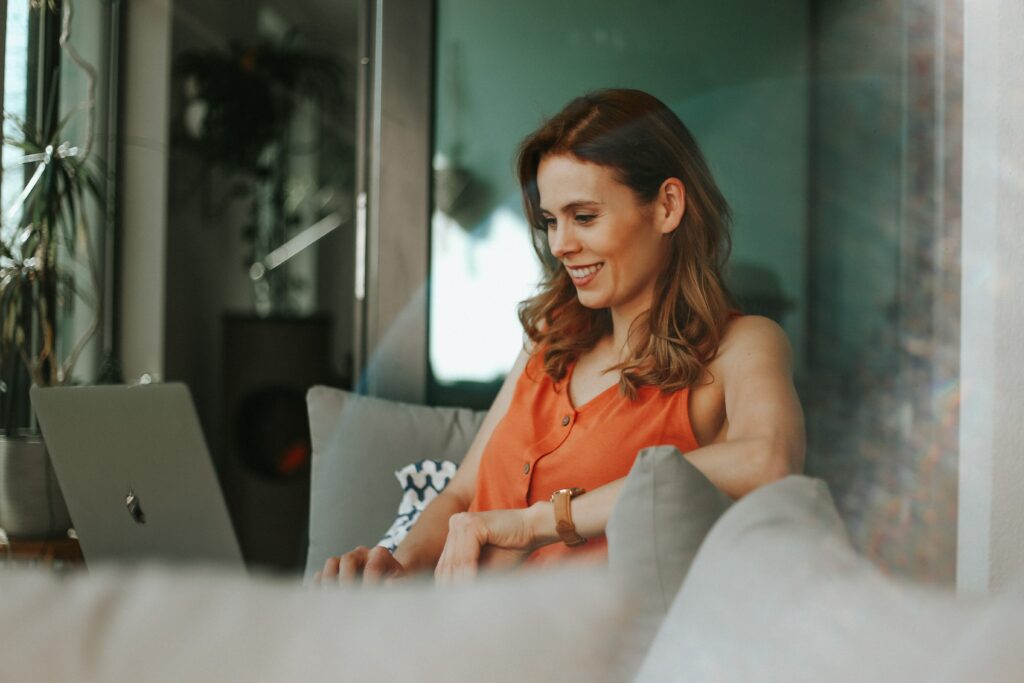
Let’s go into a bit more detail on each section:
1. Executive Summary
An executive summary is essentially a summary of your interior design business plan, so it’s best to write this section last. It should include key points, so if someone were to only read this section, they’d still have an understanding of your business and what you’re trying to achieve.
Your executive summary should include:
- Business name and type of business (e.g. sole trader or LTD company)
- A summary of the services you’ll offer and/or products you intend to sell
- Mission statement: What is the aim of your business? (e.g. become the number one interior design service in your area)
- Goals and objectives: It’s good to include short, mid, and long-term goals. (e.g. generate [amount] of profit in the first year)
- Financial summary: Financial goals and any secured or required funding
- Keys to success: How will you achieve your objectives? (e.g. provide high-quality services and first-class communication)

2. Elevator Pitch
An elevator pitch is a short summary of your business. It’s what you’ll tell people when they ask what your business does. Writing down an elevator pitch will help ensure you have a clear idea of your business direction and enable you to give a concise, well-formed description when you explain your business to others.
It should include:
- What your business does
- Who your target audience is
- Your unique selling point (USP): What sets you apart from competitors?
3. About the Business Owner
Add a bit about yourself, why you want to start an interior design business, and any experience you have in the industry. Things to cover include:
- Who are you?
- Why do you want to start this business?
- What experience do you have?
- Relevant qualifications and training
- Relevant hobbies and interests
4. Services you’ll Offer
How is your business going to make its money? Explain the different interior design services your business will offer and whether you’ll also sell any physical products.
- A list of services you’ll offer as an interior designer
- Any products you’ll sell
- Plans for future products and services
5. Business Structure
Will you work as a sole trader and hire contractors to help, or will you hire employees? Do you have a network of suppliers in place to help you carry out your projects? Include information on your employees, contractors, suppliers, and their roles in this section:
- Whether you’ll hire full-time employees or outsource to contractors
- Job roles and responsibilities
- List of suppliers needed to help fulfil projects

6. Market Summary
The market summary section of your business plan should include information about the current market and market trends, your target audience, and competitors. This section will not only help outsiders understand your target market, but it’ll also help you understand how best to advertise your products and services.
Your market summary can be split into a few sections:
Target customers
- Target customer profile: Who are your target customers?
- Who are you selling to? (e.g. businesses or individuals, residential or commercial)
- Why do they/will they buy from you?
- Any already confirmed orders
Competitors
- Who are your competitors?
- What’s your USP? What makes your business different?
- SWOT analysis: Strengths, Weaknesses, Opportunities and Threats
Market research
- Size of market
- Market trends
- Field research (Ask prospective customers what they think about your business idea)
7. Sales and Marketing Strategy
How will you reach your target customers, and what channels will you sell your products through? What price point will you sell your services at? The sales and marketing strategy section should cover:
- Sources of income: How will you sell your products and services? (E.g. online services, products, commercial and residential projects)
- Marketing channels: How will you advertise your products and services?
(E.g. word of mouth, social media, direct mail, trade shows)
- Pricing strategy: What price point and why?
- Are you likely to get repeat customers or retainer clients?

8. Business Operations
This section covers the day-to-day running of your business, what’s involved in each interior design project or the production of any products you sell, where your business will operate, what equipment and insurance you’ll need, etc.
- Production/projects: How long will it take, how much will it cost you?
- Payment: How will customers pay? (e.g. upfront, deposit, payment plan)
- List of suppliers: Who are your suppliers?
- Business premises: Where will your business operate from?
- Equipment needed: What equipment do you need for your business to operate?
- Licenses and insurance: What licenses and insurance do you need for your business to operate?
There are various expenses involved in running a business, so you’ll need to list these. Your expenses will include things like:
- Business premises
- Employee/contractor wages
- Merchandise production
- Loan repayments
- Financial Forecasts
Financial forecasts can be tricky if you’re just starting out, but try to put together a realistic calculation for the next three to five years. Essentially, you need to prove that your business will survive and become profitable. If you’re a small business or startup, speaking to an adviser at your bank may help with forecasting.
Your financial forecasts should include:
- Historical sales figures from the last three to five years (if applicable)
- Sales forecast: How much money you expect the business to take
- Profit forecast: How much profit you expect the business to make
- Monthly cash flow and business bank balance
- Balance sheet: Your business’ assets, liabilities and stockholders’ equity (smaller businesses may not require this
As you can see, a lot goes into starting your own interior design business. And while creating a business plan might seem like a long process, it’ll definitely help you in the long run.
About The Author
Freddie Chatt
Related posts, transforming spaces: the integration of ai interior design, 7 of the best free interior designer courses online, 5 key seo tips for interior designers: rank your interior design website, 14 tips for your interior design blog: get more clients from your blog.
- Credit cards
- View all credit cards
- Banking guide
- Loans guide
- Insurance guide
- Personal finance
- View all personal finance
- Small business
- Small business guide
- View all taxes
You’re our first priority. Every time.
We believe everyone should be able to make financial decisions with confidence. And while our site doesn’t feature every company or financial product available on the market, we’re proud that the guidance we offer, the information we provide and the tools we create are objective, independent, straightforward — and free.
So how do we make money? Our partners compensate us. This may influence which products we review and write about (and where those products appear on the site), but it in no way affects our recommendations or advice, which are grounded in thousands of hours of research. Our partners cannot pay us to guarantee favorable reviews of their products or services. Here is a list of our partners .
How to Start an Interior Design Business in 6 Steps

Eric is a former insurance writer at NerdWallet who has written for a variety of outlets including Business Insider, HuffPost and SCORE. Previously, he was an editor and writer at Fundera. Eric graduated from the University of Pittsburgh with degrees in history and English writing.
Robert Beaupre leads the SMB team at NerdWallet. He has covered financial topics as an editor for more than a decade. Before joining NerdWallet, he served as senior editorial manager of QuinStreet's insurance sites and managing editor of Insure.com. In addition, he served as an online media manager for the University of Nevada, Reno.

Many or all of the products featured here are from our partners who compensate us. This influences which products we write about and where and how the product appears on a page. However, this does not influence our evaluations. Our opinions are our own. Here is a list of our partners and here's how we make money .
Starting an interior design business is a popular move for people who study the craft of creating a space that's both functional and aesthetically pleasing. The combination of expressing yourself and executing your vision for clients is tough to pass up, despite the obstacles that small business owners often face.
Being successful in the field of interior design requires more than just an eye for decoration, though.
Starting with the fact that interior designers require a degree from an accredited university (those without a degree are interior decorators ), they also need extensive knowledge of the materials, software applications, and structural and health codes required to build out a home or business. There is also the matter of business acumen, the ability to balance your artistic expression with the needs and wants of the client, and the time and paperwork it takes to actually start a business.
“Great design is the marriage of form and function in a balanced and harmonious whole—and staying on budget while doing it,” says Beverly Solomon of Beverly Solomon Design.
“So yes, the artist in me can often want to do things that are more challenging, out of the box, and often expensive than the client is looking for, but listening in order to understand what the client hopes you can achieve is the major skill you must develop.”
Solomon’s international firm is based just outside of Austin, Texas, on a historic farm where she lives and works with her husband, artist Pablo Solomon. She self-financed the creation of the business after working in sales and marketing for various big-name companies, including Ralph Lauren and Revlon.
Like how each interior design business has a different focus, clientele, and model—every state has different rules and regulations for opening a small business. If you've been wondering how to start an interior design business of your own, read on for the steps you'll need to follow.

How to start an interior design business: The ultimate guide
As we mentioned, setting up an interior design business is a balancing act. As a creative, your ultimate goal is to create a business where you can use your eye for design on a daily basis. But before you can pursue your passion in the form of a legal business, you'll have to complete some tasks. Let's take a closer look at what you need to do to open an interior design business.
Step 1: Choose your business name and structure
Once you're ready to start an interior design business, you'll first need to choose a business name and decide what kind of business entity you want to use. It may be tempting to put one or both of these things off, but they will be necessary to continue with the following steps of starting an interior design business.
Luckily, most interior designers use their own names as their business name, which may increase the likelihood that your name is available for use. Either way, you will want to check the availability of business names in the state where you'll be operating your interior design business, which can typically be done through the website of your secretary of state.
After confirming that the name you want is available, you'll likely be able to reserve this name for a specified time period while you gather the other items necessary to officially register your business.
At this stage of setting up your interior design business, you'll also need to choose a business entity, such as a sole proprietorship, LLC, or corporation. The business entity you choose will affect your company's business taxes, as well as the level of risk you're exposing yourself to if any legal issues arise.
It will also depend on whether you're starting your interior design business yourself or with a partner. We recommend consulting a business attorney if you're unsure which entity to choose, as they can guide you in the best direction for your specific needs.
How much do you need?
with Fundera by NerdWallet
We’ll start with a brief questionnaire to better understand the unique needs of your business.
Once we uncover your personalized matches, our team will consult you on the process moving forward.
Step 2: Prepare and plan for your interior design business
The next step in starting an interior design business is to create your business plan. A business idea is just that, an idea, but your business plan shows exactly how you plan to take that idea and turn it into a profitable business. Not only is a business plan a vital tool for you to use as a roadmap when your interior design business is starting out (and continuing to grow), but it's also necessary if you plan to seek funding, as banks or investors will want formal documentation that you have a plan for how to turn a profit.
As such, your business plan will include everything from an overview of your company's leadership team and legal structure (which is why we chose a business entity in Step 1) to a market analysis and plan for how you'll market your own company, rundown of the exact types of services you'll offer as an interior designer, and (most importantly to potential investors) a financial plan with at least three years of financial projections.
If this is your first entrepreneurial endeavor, a business plan can seem overwhelming. The good news is you can use a business plan template or business plan software to make the process easier and ensure you're not leaving out any important information.
One part of the business plan for your interior design business that you can really build out is your plan for supplies, customers, and how you'll generate hype around your new interior design business so you can turn a profit.
Tips to connect with suppliers, customers, and media outlets
Interior design is an industry-driven by connections. You’ll need them to find your clients, to market yourself, and to establish fruitful relationships with suppliers of materials and furniture. And this is a key part of planning for your interior design business.
“I began my business by basically selling the art of my husband to high-end clients. When they began asking our design advice on various projects, I saw an opportunity,” says Solomon. “I decided that I wanted to use my expertise, experience, and connections from working with the major designers to start my own businesses.”
Solomon says that creating connections with the media has helped her in everything from marketing her interior design business to letting her set the price point.
“In art and design, you're selling your abilities, but what really sets the price you can get is your name recognition,” she says. “I knew from my days in sales and marketing that the place to focus was on name recognition. So we concentrated on building relationships with those in the media who could put our names out there.
“One of the secrets to our success has been working with writers, publishers, photographers, filmmakers, and producers to create symbiotic relationships that have resulted in their getting good information, interesting stories, illustrations, photographs, connections, and advice. In return, we've gotten literally hundreds of thousands of dollars of free publicity and built strong name recognition.”
Another common way to leverage connections is to form relationships with manufacturers in order to get the best deals on products or when buying in bulk. If you find yourself drawn to a company that builds in a similar style to your own, you’re in good shape—but don’t hamstring yourself, Solomon advises.
“Teaming up with various furniture stores and manufacturers can be as tricky as it is rewarding. Make sure that you're finding a good match, and not just a deal out of desperation. Pushing products that are absolutely the best for your client is a good thing, but pushing crap can ruin your reputation,” she says.
Thinking through your own strategy to form connections and market your interior design business should be included in your business plan, both for your own reference, as well as to show potential investors you're serious about your business.
Step 3: Register your interior design business and get an EIN
The next step in starting your interior design business will be to use the name you secured in Step 1 and register your business. The registration process varies in each state, as does where and how you'll register your business .
Some states will allow you to register online while others require you to submit forms via mail. In most states, you'll likely deal with the secretary of state's office, while other states specifically have branches of government for small businesses.
You should also register your interior design business with the IRS and apply for an employer identification number, or an EIN. This can take a matter of minutes online and you could be approved right away.
There are a number of benefits of getting an EIN, even if it's not required for your business. For instance, it makes it easier to file your business taxes, get credit reports, hire employees, open a business bank account, and more.
Step 4: Obtain any licenses or business permits
You're now well on your way to setting up an interior design business. Once you've registered your business, you're ready to obtain the appropriate business licenses or permits. Like the registration process, this will also depend on where your interior design business will be located and which government regulations apply.
Depending on where you're located, you might need to meet specific interior designer license benchmarks as well: 24 states have passed interior design legislation to this effect.
Check with the Small Business Administration or your local chamber of commerce to see which city, county, and state permits you need to start your interior design business. You might also need a sellers permit and sales tax license, and if you have employees, you’ll need a federal employer identification number for tax purposes as well (if you didn't already set this up in the previous step).
Step 5: Open a business bank account and get a business credit card
The next step in starting an interior design business is to set up a business bank account and business credit card . Not only will this help you establish business credit, but it will also be vital to keep your business expenses separate from your personal spending for tax and funding purposes, as well as just more easily be able to manage your business finances.
While you may be tempted to go with the same bank that you have a personal account with, don't assume this is your best option. Business banking needs are different from your personal ones, and you'll want to consider things like minimum balance requirements, monthly fees, how many monthly transactions you'll be allowed, your need for ATM access, and more when choosing a business bank account.
The majority of businesses will benefit most from a business checking account , but if your interior design business starts making a profit and you can keep that money in a bank account instead of investing it back into the business, you may also consider a high yield savings account to help your money grow.
Likewise, you will want a business credit card that's separate from your personal one so you can easily keep track of your business expenses. Again, you'll want to consider what you need from a business credit card before choosing the best one for you.
Credit cards with a 0% introductory APR can be an especially appealing option for businesses that are just starting out and may not yet qualify for funding options. With these types of cards, you can purchase bigger items for your business upfront and pay them back without interest. Just make sure if you do opt for this strategy that you're aware of when the 0% APR offer ends and are confident that you can pay off your balance by that date.
Step 6: Explore funding options
As you consider the finances of your interior design business, you may find you need additional funding to get your business off the ground. The saying, "You need to spend money to make money," rings true for new businesses—especially in an industry like interior design where each project will require you to spend a significant amount of money on materials and supplies, while you may only receive payment once the job is completed.
Exploring your business loan options is a good idea to see what possibilities you have and what solution you can find for your business. You may find a startup loan is right for you, or a line of credit or invoice financing may be a better fit.
You should also think carefully about what parts of your business you will spend the money on, as well as how much you need and a plan for how you'll pay it back.
How to Iinvest in the basics
As Solomon advises, you don’t necessarily need to invest in an office space, especially when first starting out. There are other basics that you’ll need first, including:
Fabric samples and design accessories: Sample books with various styles, colors, and textures will help you and your client better understand each other’s vision for their space.
Room decor: Whether your office is on the main street in town or your home, having pieces from different manufacturers and collections gives your clients an understanding of your range, as well as ideas for their own project.
Professional group memberships: For example, joining the American Society of Interior Designers (ASID) gives you access to marketing and development advice and tools, professional education opportunities, and other benefits that depend on the regional ASID office. Mentorships and advice from those already established in the industry are especially valuable when you're first starting your interior design business.

LLC Formation
How to start an interior design business: The bottom line
“Never forget that interior design is as much about how the client wants a space to feel as to how the client wants it to look ,” says Solomon.
This speaks to the fact that interior design is a unique business: It asks owners and directors to balance their own need for artistic expression with both practical logistics and the requests of the client. It's a complicated job, to be sure.
There’s plenty of the usual responsibilities that fall to small business owners in interior design—coordinating marketing efforts, hiring and managing employees, controlling inventory, and monitoring the supply chain. But there’s also the added element of creating the spaces in which people work, live, and play—a powerful form of expression that for many will be worth the challenges.
This article originally appeared on JustBusiness, a subsidiary of NerdWallet.

Business Plan Template for Interior Designers
- Great for beginners
- Ready-to-use, fully customizable Subcategory
- Get started in seconds

Starting an interior design business can be an exciting but challenging venture. To set yourself up for success, you need a well-crafted business plan that captures your vision and outlines your strategies. Look no further than ClickUp's Business Plan Template for Interior Designers!
This template will help you:
- Define your goals and establish a clear roadmap for your business
- Create a comprehensive marketing strategy to attract your ideal clients
- Develop accurate financial projections to ensure profitability
- Streamline your operational processes for efficient project management
With ClickUp's Business Plan Template for Interior Designers, you'll have all the tools you need to turn your passion for design into a thriving business. Get started today and make your dreams a reality!
Business Plan Template for Interior Designers Benefits
When using the Business Plan Template for Interior Designers, you can expect the following benefits:
- Clear direction: The template helps you outline your goals and strategies, providing a roadmap for your interior design business.
- Effective marketing: You can define your target audience, create marketing strategies, and differentiate yourself from competitors.
- Financial projections: The template helps you estimate costs, set pricing, and forecast revenue, ensuring profitability and financial stability.
- Streamlined operations: Outline your processes, workflow, and project management strategies to ensure efficient operations.
- Client attraction: With a well-crafted business plan, you can showcase your expertise, professionalism, and unique value proposition to attract clients.
Main Elements of Interior Designers Business Plan Template
As an interior designer, staying organized and focused is key to running a successful business. ClickUp’s Business Plan Template for Interior Designers provides the essential tools to streamline your operations and achieve your goals.
Here are the main elements of this template:
- Custom Statuses: Keep track of the progress of each section of your business plan with statuses like Complete, In Progress, Needs Revision, and To Do.
- Custom Fields: Utilize fields like Reference, Approved, and Section to add specific information to each task and easily categorize and filter your business plan.
- Custom Views: Access five different views tailored to your needs, including Topics, Status, Timeline, Business Plan, and Getting Started Guide. These views allow you to organize your plan, track progress, and visualize your timeline in a way that suits your workflow.
With ClickUp's Business Plan Template for Interior Designers, you can confidently manage your business, attract clients, and achieve your goals.
How To Use Business Plan Template for Interior Designers
If you're an interior designer looking to create a solid business plan, ClickUp has a template designed specifically for you. Follow these steps to effectively use the Business Plan Template for Interior Designers:
1. Define your vision and mission
Start by clearly defining your vision and mission for your interior design business. What sets you apart from others? What do you hope to achieve? This will serve as the foundation for your business plan.
Use a Doc in ClickUp to articulate your vision and mission statement for your interior design business.
2. Identify your target market
Next, identify your target market. Who are your ideal clients? What demographics do they fall into? Understanding your target market will help you tailor your marketing efforts and services to attract and serve them effectively.
Use custom fields in ClickUp to track information about your target market, such as demographics, preferences, and needs.
3. Analyze the competition
Conduct a thorough analysis of your competition. Who are your main competitors in the interior design industry? What are their strengths and weaknesses? This analysis will help you identify opportunities for differentiation and determine how you can position your business in the market.
Create tasks in ClickUp to research and analyze your competition, noting their strengths and weaknesses.
4. Develop your services and pricing
Outline the specific services you will offer as an interior designer. Will you focus on residential or commercial projects? What design styles will you specialize in? Additionally, determine your pricing structure based on your target market and competition.
Use custom fields in ClickUp to define your services and pricing for easy reference and tracking.
5. Create a marketing and sales strategy
Finally, develop a comprehensive marketing and sales strategy to promote your interior design business. How will you reach your target market? What channels and tactics will you use to generate leads and convert them into clients?
Use the Gantt chart in ClickUp to create a timeline for your marketing and sales activities, outlining when each tactic will be implemented.
By following these steps and using ClickUp's Business Plan Template for Interior Designers, you'll have a clear roadmap for success and be well on your way to building and growing your interior design business.
Get Started with ClickUp’s Business Plan Template for Interior Designers
Interior design firms or individual interior designers can use the Business Plan Template in ClickUp to create a comprehensive plan for their business and streamline their operations.
To get started, click on "Add Template" to sign up for ClickUp and add the template to your Workspace. Make sure you designate which Space or location in your Workspace you’d like this template applied.
Next, invite relevant team members or guests to your Workspace to start collaborating.
Now you can take advantage of the full potential of this template to create a successful interior design business:
- Use the Topics View to outline the main sections of your business plan, such as goals, target market, marketing strategies, and financial projections.
- The Status View allows you to track the progress of each section, with statuses like Complete, In Progress, Needs Revision, and To Do.
- The Timeline View helps you visualize the timeline for completing each section and ensures that you stay on track.
- The Business Plan View provides a comprehensive overview of your entire business plan, allowing you to easily navigate and make updates.
- The Getting Started Guide View provides a step-by-step guide to help you fill out each section of the business plan.
- Utilize the custom fields Reference, Approved, and Section to add additional information and categorize different sections of your plan.
- Update statuses as you complete each section to keep track of progress and ensure that all areas of your business plan are addressed.
- Regularly review and analyze your business plan to ensure that it aligns with your goals and objectives, and make any necessary revisions to keep it up to date.
- Business Plan Template for Computer Engineers
- Business Plan Template for Educators
- Business Plan Template for Clothing Manufacturers
- Business Plan Template for Podcasters
- Business Plan Template for Limousine Services
Template details
Free forever with 100mb storage.
Free training & 24-hours support
Serious about security & privacy
Highest levels of uptime the last 12 months
- Product Roadmap
- Affiliate & Referrals
- On-Demand Demo
- Integrations
- Consultants
- Gantt Chart
- Native Time Tracking
- Automations
- Kanban Board
- vs Airtable
- vs Basecamp
- vs MS Project
- vs Smartsheet
- Software Team Hub
- PM Software Guide

Interior Design Business Plan Template
If you want to start an interior design business or expand your current one, you need a business plan.
Over the past 20+ years, we have helped over 7,000 entrepreneurs and business owners create business plans to start and grow their interior design businesses.
Below are links to each section of your interior design business plan template :
Next Section: Executive Summary >
Interior Design Business Plan FAQs
What is the easiest way to complete my interior design business plan.
Growthink's Ultimate Business Plan Template allows you to quickly and easily complete your Interior Design Business Plan.
What Is an Interior Design Business Plan?
A business plan provides a snapshot of your interior design business as it stands today, and lays out your growth plan for the next five years. It explains your business goals and your strategy for reaching them. It also includes market research to support your plans.
Why Do You Need a Business Plan for an Interior Design Business?
If you’re looking to start an interior design business or grow your existing interior design business you need a business plan. A business plan will help you raise funding, if needed, and plan out the growth of your interior design business in order to improve your chances of success. Your interior design business plan is a living document that should be updated annually as your business grows and changes.
What Are the Sources of Funding for an Interior Design business?
Interior Design businesses are usually funded through small business loans, personal savings, credit card financing and/or angel investors.
INTERIOR DESIGN BUSINESS PLAN OUTLINE
- Interior Design Business Plan Home
- 1. Executive Summary
- 2. Company Overview
- 3. Industry Analysis
- 4. Customer Analysis
- 5. Competitive Analysis
- 6. Marketing Plan
- 7. Operations Plan
- 8. Management Team
- 9. Financial Plan
- 10. Appendix
- Interior Design Business Plan Summary
Start Your Interior Design Plan Here
Other Helpful Business Plan Articles & Templates


How To Write a Winning Interior Design Business Plan + Template
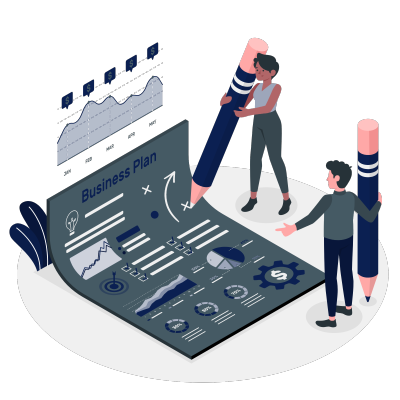
Creating a business plan is essential for any business, but it can be especially helpful for interior design businesses who want to improve their strategy and/or raise funding.
A well-crafted business plan not only outlines the vision for your company, but also documents a step-by-step roadmap of how you are going to accomplish it. In order to create an effective business plan, you must first understand the components that are essential to its success.
This article provides an overview of the key elements that every interior design business owner should include in their business plan.
Download the Ultimate Business Plan Template
What is an Interior Design Business Plan?
An interior design business plan is a formal written document that describes your company’s business strategy and its feasibility. It documents the reasons you will be successful, your areas of competitive advantage, and it includes information about your team members. Your business plan is a key document that will convince investors and lenders (if needed) that you are positioned to become a successful venture.
Why Write an Interior Design Business Plan?
An interior design business plan is required for banks and investors. The document is a clear and concise guide of your business idea and the steps you will take to make it profitable.
Entrepreneurs can also use this as a roadmap when starting their new company or venture, especially if they are inexperienced in starting a business.
Writing an Effective Interior Design Business Plan
The following are the key components of a successful interior design business plan:
Executive Summary
The executive summary of an interior design business plan is a one to two page overview of your entire business plan. It should summarize the main points, which will be presented in full in the rest of your business plan.
- Start with a one-line description of your interior design
- Provide a short summary of the key points in each section of your business plan, which includes information about your company’s management team, industry analysis, competitive analysis, and financial forecast among others.
Company Description
This section should include a brief history of your company. Include a short description of how your company started, and provide a timeline of milestones your company has achieved.
If you are just starting your interior design business, you may not have a long company history. Instead, you can include information about your professional experience in this industry and how and why you conceived your new venture. If you have worked for a similar company before or have been involved in an entrepreneurial venture before starting your interior design firm, mention this.
You will also include information about your chosen interior design business model and how, if applicable, it is different from other companies in your industry.
Industry Analysis
The industry or market analysis is an important component of an interior design business plan. Conduct thorough market research to determine industry trends and document the size of your market.
Questions to answer include:
- What part of the interior design industry are you targeting?
- How big is the market?
- What trends are happening in the industry right now (and if applicable, how do these trends support the success of your company)?
You should also include sources for the information you provide, such as published research reports and expert opinions.
Customer Analysis
This section should include a list of your target audience(s) with demographic and psychographic profiles (e.g., age, gender, income level, profession, job titles, interests). You will need to provide a profile of each customer segment separately, including their needs and wants.
For example, an interior design business’ customers may include:
- Businesses (office, retail, and hospitality firms)
- Other designers, architects, and homebuilders
You can include information about how your customers make the decision to buy from you as well as what keeps them buying from you.
Develop a strategy for targeting those customers who are most likely to buy from you, as well as those that might be influenced to buy your products or interior design services with the right marketing.
Competitive Analysis
The competitive analysis helps you determine how your product or service will be different from competitors, and what your unique selling proposition (USP) might be that will set you apart in this industry.
For each competitor, list their strengths and weaknesses. Next, determine your areas of competitive differentiation and/or advantage; that is, in what ways are you different from and ideally better than your competitors.
Marketing Plan
This part of the business plan is where you determine and document your marketing plan. . Your plan should be clearly laid out, including the following 4 Ps.
- Product/Service : Detail your product/service offerings here. Document their features and benefits.
- Price : Document your pricing strategy here. In addition to stating the prices for your products/services, mention how your pricing compares to your competition.
- Place : Where will your customers find you? What channels of distribution (e.g., partnerships) will you use to reach them if applicable?
- Promotion : How will you reach your target customers? For example, you may use social media, write blog posts, create an email marketing campaign, use pay-per-click advertising, launch a direct mail campaign. Or you may promote your interior design business via public relations, speaking engagements, or networking.
Operations Plan
This part of your interior design business plan should include the following information:
- How will you deliver your product/service to customers? For example, will you do it in person or over the phone only?
- What infrastructure, equipment, and resources are needed to operate successfully? How can you meet those requirements within budget constraints?
The operations plan is where you also need to include your company’s business policies. You will want to establish policies related to everything from customer service to pricing, to the overall brand image you are trying to present.
Finally, and most importantly, in your Operations Plan, you will lay out the milestones your company hopes to achieve within the next five years. Create a chart that shows the key milestone(s) you hope to achieve each quarter for the next four quarters, and then each year for the following four years. Examples of milestones for an interior design business include reaching $X in sales. Other examples include hitting certain customer targets or partnering with specific retailers or distributors.
Management Team
List your team members here including their names and titles, as well as their expertise and experience relevant to your specific interior design industry. Include brief biography sketches for each team member.
Particularly if you are seeking funding, the goal of this section is to convince investors and lenders that your team has the expertise and experience to execute on your plan. If you are missing key team members, document the roles and responsibilities you plan to hire for in the future.
Financial Plan
Here you will include a summary of your complete and detailed financial plan (your full financial projections go in the Appendix).
This includes the following three financial statements:
Income Statement
Your income statement should include:
- Revenue : how much revenue you generate.
- Cost of Goods Sold : These are your direct costs associated with generating revenue. This includes labor costs, as well as the cost of any equipment and supplies used to deliver the product/service offering.
- Net Income (or loss) : Once expenses and revenue are totaled and deducted from each other, this is the net income or loss.
Sample Income Statement for a Startup Interior Design Business
| Revenues | $ 336,090 | $ 450,940 | $ 605,000 | $ 811,730 | $ 1,089,100 |
| $ 336,090 | $ 450,940 | $ 605,000 | $ 811,730 | $ 1,089,100 | |
| Direct Cost | |||||
| Direct Costs | $ 67,210 | $ 90,190 | $ 121,000 | $ 162,340 | $ 217,820 |
| $ 67,210 | $ 90,190 | $ 121,000 | $ 162,340 | $ 217,820 | |
| $ 268,880 | $ 360,750 | $ 484,000 | $ 649,390 | $ 871,280 | |
| Salaries | $ 96,000 | $ 99,840 | $ 105,371 | $ 110,639 | $ 116,171 |
| Marketing Expenses | $ 61,200 | $ 64,400 | $ 67,600 | $ 71,000 | $ 74,600 |
| Rent/Utility Expenses | $ 36,400 | $ 37,500 | $ 38,700 | $ 39,800 | $ 41,000 |
| Other Expenses | $ 9,200 | $ 9,200 | $ 9,200 | $ 9,400 | $ 9,500 |
| $ 202,800 | $ 210,940 | $ 220,871 | $ 230,839 | $ 241,271 | |
| EBITDA | $ 66,080 | $ 149,810 | $ 263,129 | $ 418,551 | $ 630,009 |
| Depreciation | $ 5,200 | $ 5,200 | $ 5,200 | $ 5,200 | $ 4,200 |
| EBIT | $ 60,880 | $ 144,610 | $ 257,929 | $ 413,351 | $ 625,809 |
| Interest Expense | $ 7,600 | $ 7,600 | $ 7,600 | $ 7,600 | $ 7,600 |
| $ 53,280 | $ 137,010 | $ 250,329 | $ 405,751 | $ 618,209 | |
| Taxable Income | $ 53,280 | $ 137,010 | $ 250,329 | $ 405,751 | $ 618,209 |
| Income Tax Expense | $ 18,700 | $ 47,900 | $ 87,600 | $ 142,000 | $ 216,400 |
| $ 34,580 | $ 89,110 | $ 162,729 | $ 263,751 | $ 401,809 | |
| 10% | 20% | 27% | 32% | 37% | |
Balance Sheet
Include a balance sheet that shows your assets, liabilities, and equity. Your balance sheet should include:
- Assets : All of the things you own (including cash).
- Liabilities : This is what you owe against your company’s assets, such as accounts payable or loans.
- Equity : The worth of your business after all liabilities and assets are totaled and deducted from each other.
Sample Balance Sheet for a Startup Interior Design Business
| Cash | $ 105,342 | $ 188,252 | $ 340,881 | $ 597,431 | $ 869,278 |
| Other Current Assets | $ 41,600 | $ 55,800 | $ 74,800 | $ 90,200 | $ 121,000 |
| Total Current Assets | $ 146,942 | $ 244,052 | $ 415,681 | $ 687,631 | $ 990,278 |
| Fixed Assets | $ 25,000 | $ 25,000 | $ 25,000 | $ 25,000 | $ 25,000 |
| Accum Depreciation | $ 5,200 | $ 10,400 | $ 15,600 | $ 20,800 | $ 25,000 |
| Net fixed assets | $ 19,800 | $ 14,600 | $ 9,400 | $ 4,200 | $ 0 |
| $ 166,742 | $ 258,652 | $ 425,081 | $ 691,831 | $ 990,278 | |
| Current Liabilities | $ 23,300 | $ 26,100 | $ 29,800 | $ 32,800 | $ 38,300 |
| Debt outstanding | $ 108,862 | $ 108,862 | $ 108,862 | $ 108,862 | $ 0 |
| $ 132,162 | $ 134,962 | $ 138,662 | $ 141,662 | $ 38,300 | |
| Share Capital | $ 0 | $ 0 | $ 0 | $ 0 | $ 0 |
| Retained earnings | $ 34,580 | $ 123,690 | $ 286,419 | $ 550,170 | $ 951,978 |
| $ 34,580 | $ 123,690 | $ 286,419 | $ 550,170 | $ 951,978 | |
| $ 166,742 | $ 258,652 | $ 425,081 | $ 691,831 | $ 990,278 | |
Cash Flow Statement
Include a cash flow statement showing how much cash comes in, how much cash goes out and a net cash flow for each year. The cash flow statement should include:
- Cash Flow From Operations
- Cash Flow From Investments
- Cash Flow From Financing
Below is a sample of a projected cash flow statement for a startup interior design business.
Sample Cash Flow Statement for a Startup Interior Design Business
| Net Income (Loss) | $ 34,580 | $ 89,110 | $ 162,729 | $ 263,751 | $ 401,809 |
| Change in Working Capital | $ (18,300) | $ (11,400) | $ (15,300) | $ (12,400) | $ (25,300) |
| Plus Depreciation | $ 5,200 | $ 5,200 | $ 5,200 | $ 5,200 | $ 4,200 |
| Net Cash Flow from Operations | $ 21,480 | $ 82,910 | $ 152,629 | $ 256,551 | $ 380,709 |
| Fixed Assets | $ (25,000) | $ 0 | $ 0 | $ 0 | $ 0 |
| Net Cash Flow from Investments | $ (25,000) | $ 0 | $ 0 | $ 0 | $ 0 |
| Cash from Equity | $ 0 | $ 0 | $ 0 | $ 0 | $ 0 |
| Cash from Debt financing | $ 108,862 | $ 0 | $ 0 | $ 0 | $ (108,862) |
| Net Cash Flow from Financing | $ 108,862 | $ 0 | $ 0 | $ 0 | $ (108,862) |
| Net Cash Flow | $ 105,342 | $ 82,910 | $ 152,629 | $ 256,551 | $ 271,847 |
| Cash at Beginning of Period | $ 0 | $ 105,342 | $ 188,252 | $ 340,881 | $ 597,431 |
| Cash at End of Period | $ 105,342 | $ 188,252 | $ 340,881 | $ 597,431 | $ 869,278 |
You will also want to include an appendix section which will include:
- Your complete financial projections
- A complete list of your company’s business policies and procedures related to the rest of the business plan (marketing, operations, etc.)
- Any other documentation which supports what you included in the body of your business plan.
Writing a good business plan gives you the advantage of being fully prepared to launch and/or grow your interior design company . It not only outlines your business vision but also provides a step-by-step process of how you are going to accomplish it.
A well-written business plan is an essential tool for any interior design business. The tips we’ve provided in this article should help you write a winning business plan for your interior design firm.
Finish Your Business Plan in 1 Day!
Wish there was a faster, easier way to finish your business plan?
With our Ultimate Business Plan Template you can finish your plan in just 8 hours or less!
Other Helpful Articles
How To Develop Your Interior Design Mission Statement + Examples
Detailing the Interior Design Scope of Work + Template & Sample
Interior Design Business Forms & Templates
Interior Design Client Questionnaire: What You Should Ask Your Clients + Template
Interior Design Contracts & Agreements: What To Include + Sample Template
- Project Management
Design Manager Blog
- Accounting (33)
- Business of Design (102)
- Creative Conversations (43)
- Design Manager Tips (44)
- Did You Know (27)
- eco-friendly interior design (1)
- Interior Design (79)
- Lifestyle (24)
- luxury interior design (2)
- New Features (7)
- Productivity (42)
- Social Media (12)
- sustainable interior design (2)
- Technology (22)
- Trade Talk (39)
- Business of Design
How to Write a Business Plan for Your Interior Design Business
7 ways to create luxury interior design on a limited budget.

- Margot LaScala July 31 2023 . 7 min read
Starting your own interior design business is a special time filled with firsts. It’s easy to get swept up in the excitement and forget to iron out the finer details. Writing a business plan is the best first step you can take when it comes to starting your interior design business because in doing so, you’ll force yourself to get specific about your dreams, look at the practicals, and carve out a clear course of action. Your business plan is your roadmap for setting up your business processes, spreading the word about your services, and finding new clients. Let’s get started!

Step 1: Determine Your Niche
You have the opportunity to create the interior design business of your dreams. While the project possibilities are endless, it’s important to define your niche. Defining your niche will set you apart from your competition by making you a specialist in a specific design style, a certain type of space, a particular type of client, or even for designing within a certain budgetary range.
According to Carla Aston, there are many ways to find your niche. "I think it’s important after each project or even consultation, if you do those, to reflect back and make notes of what sparked joy within you." Maybe you love the farmhouse look, traditional homes, or a more sleek and modern style. You might also want to ask yourself who you enjoy working with. Maybe you’ve found that certain types of clients, like young families or single millennials, are consistently a delight for you to collaborate with, or perhaps there’s a certain type of space like kitchens or luxury hotels that you genuinely enjoy designing.
Once you’ve found your niche, it’s important to develop a detailed understanding of who your ideal clients are, the pain points they’re likely facing, and what their desires are, so you can develop a design process that delights them at every touchpoint. This will also help you create a marketing strategy that speaks straight to the hearts of those seeking out your services and positions you as the obvious choice.
"Over time, I've developed budget parameters, personality traits of desired clients, style of design, size of projects, locations where I want to work, etc., that spark joy for me and I've designed my business model to accommodate only those jobs. Remember that saying no to a job that doesn't fit into your model is almost more important than saying yes to one that does,” says Aston.
Step 2: Define Your Services
The next step is to define your services. What services bring you the most joy? Some interior designers love managing projects and coordinating with tradespeople, while others would rather delegate these tasks. Decide on which services you’d like to offer and personally tend to and which you’d rather have someone else handle.
There are so many different types of interior design services you can offer . Design consultations, space planning, furniture selection, art curation, custom window treatments, plumbing, flooring, lighting, installation, and re-designs are just a few. Some services, such as construction and window design, even overlap with architecture. It’s also important to specify which types of spaces your services are for so you can attract projects you enjoy. Commercial, institutional, residential, and office spaces are just some of the spaces to consider.
Next, conduct market research by taking a look at the language your competitors are using and interviewing prospective clients about their desires and pain points. Having this information in your back pocket will help you further define your services and communicate them in a way that speaks straight to your ideal clients.
Step 3: Decide on Your Rate.
There are many questions to consider when it comes to determining your rate. For starters, how much money do you need to make at a minimum to cover your current expenses and meet your income goals? How much money will you need in addition to meet your savings goals and also to live comfortably? Next, ask yourself, in a given amount of time, how many projects can you reasonably accomplish? Will you bill hourly or charge a flat rate per project? Once you’ve decided on each of these factors, establish your rates. It all boils down to the number of projects you can do in a certain amount of time and how much money you’ll need to live comfortably.
And don’t underestimate your expertise. Sharing knowledge is a service in itself, implementing it for people will naturally cost even more. If you charge too low, you’ll give people the impression that your services aren’t as high quality as other designers who might charge more for the same services. No matter what, it’s important that you make a profit.
You can also find creative ways to save money. Develop good relationships with vendors and tradespeople and look for vendors who offer discounts for interior designers. You can also consider upcharging for materials by a certain percentage.
Most importantly, when sharing your rate with your clients, it’s important to communicate your process to them and explain the amount of time that’s involved. Your clients will never understand how much work goes into a single project unless you clearly define the scope and lay out all of the details for them.
Step 4: Develop a Marketing Strategy.
Now, it’s time to get started on your marketing strategy. Where do you want to be in 5 years? Dream big. For example, do you need a certain number of projects by a certain time? Do you want your work to be published in a certain magazine or a certain number of magazines to help build brand awareness and showcase your work? Marketing yourself well will get you there.
The best way to spread the word is by word of mouth. Attend networking events and local interior design shows. Build relationships with local vendors, and hand out business cards and other marketing collateral. When people enjoy working with you and love the quality of your work, they’ll naturally want to tell everyone about your services. This is why it’s important to create the best client experience possible where you delight your clients at every stage of the process, which begins with building a beautiful and consistent brand.
Develop a consistent brand that reflects the personality of your business as well as your niche. You’ll need a logo and a beautifully designed website that matches the quality of your work. If you settle for anything less, you’ll be doing yourself a huge disservice, some might even call it self-sabotage.
Squarespace has stunning website templates that you can use to showcase your interior design work. There’s no need to have a lot of pages on your website—the simpler the better. For optimal results, you’ll need a homepage, about, services, portfolio, and a contact us page with testimonials and beautiful images placed throughout your site. Since interior design is largely visual, hiring a professional photographer is key.
To learn more about branding for interior designers, check out our post Identifying Individuality and Building an Authentic Brand .
And don’t forget to ask your clients for reviews about their experience working with you, and keep all of your reviews on your website. You’ll also want to create a social media presence to provide an online community for your dedicated clients and a platform to attract new ones. You can share your client reviews on social media periodically with an accompanying image or blog post. Have fun with Facebook, Instagram, Twitter, and PPC ads, and use Canva to easily create stunning social media graphics.
Step 5: Get a Solid Accounting System.
Last but not least, get a solid accounting system to make your life, or your accountant or bookkeeper’s life, easier. Design Manager is an accounting software designed with interior designers in mind. With careful item tracking, in-depth drill downs for each item, interior design specific reporting, and easy anywhere, anytime access, Design Manager can help you save time and money by streamlining your entire interior design business from anywhere in the world.
Once you’ve determined your niche, defined your services, decided on your rate, developed your marketing strategy, and found a solid accounting system, you’re well on your way to starting a successful interior design business. Write everything down so you can periodically refer back to your business plan to keep yourself on track.
Learn more about why Design Manager is the best accounting software for interior designers by checking out our interview with bookkeeper Brad Shark right here .

Angela Sanders, Contributing Author
Topics: Business of Design
Stay Connected
Related posts, spring 2023 high point market recap.
- Margot LaScala May 8 2023 . 11 min read
High Point Spring 2023 Preview: What to Expect
- Margot LaScala April 4 2023 . 10 min read
The Top Professional Associations for Interior Designers and How They Add Value
- Margot LaScala March 15 2023 . 20 min read
- Interior Design Market Calendar
- Our Partners
- Help Center
© Copyright 2024 Design Manager
- Terms of Service
- Privacy Policy

Free Download
Interior Design Business Plan Template
Download this free interior design business plan template, with pre-filled examples, to create your own plan..
Or plan with professional support in LivePlan. Save 50% today
Available formats:
What you get with this template
A complete business plan.
Text and financials are already filled out and ready for you to update.
- SBA-lender approved format
Your plan is formatted the way lenders and investors expect.
Edit to your needs
Download as a Word document and edit your business plan right away.
- Detailed instructions
Features clear and simple instructions from expert business plan writers.
All 100% free. We're here to help you succeed in business, no strings attached.
Get the most out of your business plan example
Follow these tips to quickly develop a working business plan from this sample.
1. Don't worry about finding an exact match
We have over 550 sample business plan templates . So, make sure the plan is a close match, but don't get hung up on the details.
Your business is unique and will differ from any example or template you come across. So, use this example as a starting point and customize it to your needs.
2. Remember it's just an example
Our sample business plans are examples of what one business owner did. That doesn't make them perfect or require you to cram your business idea to fit the plan structure.
Use the information, financials, and formatting for inspiration. It will speed up and guide the plan writing process.
3. Know why you're writing a business plan
To create a plan that fits your needs , you need to know what you intend to do with it.
Are you planning to use your plan to apply for a loan or pitch to investors? Then it's worth following the format from your chosen sample plan to ensure you cover all necessary information.
But, if you don't plan to share your plan with anyone outside of your business—you likely don't need everything.
More business planning resources

How to Write a Business Plan for Investors

How to Write a Business Plan

Industry Business Planning Guides

How to Start a Business With No Money

10 Qualities of a Good Business Plan

How to Create a Business Plan Presentation

Business Plan Template

Simple Business Plan Outline
Download your template now
Need to validate your idea, secure funding, or grow your business this template is for you..
- Fill-in-the-blank simplicity
- Expert tips & tricks
We care about your privacy. See our privacy policy .
Not ready to download right now? We'll email you the link so you can download it whenever you're ready.
Download as Docx
Download as PDF

Finish your business plan with confidence
Step-by-step guidance and world-class support from the #1 business planning software

The quickest way to turn a business idea into a business plan
Fill-in-the-blanks and automatic financials make it easy.
No thanks, I prefer writing 40-page documents.

Discover the world’s #1 plan building software
Interior Design Business Plan Template & Guidebook
How to write a interior design business plan in 7 steps:, 1. describe the purpose of your interior design business..
It also helps to include a vision statement so that readers can understand what type of company you want to build.
2. Products & Services Offered by Your Interior Design Business.
When you think about the products and services that you offer, it's helpful to ask yourself the following questions:
3. Build a Creative Marketing Stratgey.
If you don't have a marketing plan for your interior design business, it's time to write one. Your marketing plan should be part of your business plan and be a roadmap to your goals.
Target market
Customer base , product or service description, competitive analysis, marketing channels, form an llc in your state, 4. write your operational plan., what equipment, supplies, or permits are needed to run a interior design business, 5. management & organization of your interior design business..
The second part of your interior design business plan is to develop a management and organization section.
6. Interior Design Business Startup Expenses & Captial Needed.
Startup costs are typically the first expenses you will incur when beginning an enterprise. These include legal fees, accounting expenses, and other costs associated with getting your business off the ground. The amount of money needed to start a interior design business varies based on many different variables, but below are a few different types of startup costs for a interior design business.
You should include any costs associated with marketing and sales, such as advertising and promotions, website design or maintenance. Also, consider any additional expenses that may be incurred if you decide to launch a new product or service line. For example, if your interior design business has an existing website that needs an upgrade in order to sell more products or services, then this should be listed here.
7. Financial Plan & Projections
Here are some steps you can follow to devise a financial plan for your interior design business plan:
Frequently Asked Questions About Interior Design Business Plans:
Why do you need a business plan for a interior design business, who should you ask for help with your interior design business plan.
You should ask a professional business consultant or an experienced interior designer for help with your interior design business plan. Additionally, there are resources online, such as online templates and step-by-step guidelines or video tutorials, that can provide useful information for your plan.
Can you write a interior design business plan yourself?
Related business plans, home inventory business plan template & guidebook, home inspection business plan template & guidebook, home decor business plan template & guidebook, health and wellness business plan template & guidebook, hauling business plan template & guidebook, hardware business plan template & guidebook, handyman business plan template & guidebook, hair extension business plan template & guidebook, handbag business plan template & guidebook.
I'm Nick, co-founder of newfoundr.com, dedicated to helping aspiring entrepreneurs succeed. As a small business owner with over five years of experience, I have garnered valuable knowledge and insights across a diverse range of industries. My passion for entrepreneurship drives me to share my expertise with aspiring entrepreneurs, empowering them to turn their business dreams into reality.

Item added to your cart
Here is a free business plan sample for an interior design services.

If you have a passion for transforming spaces and a flair for design, embarking on a career as an interior designer might be your calling.
In the following paragraphs, we will present to you a comprehensive business plan tailored for aspiring interior designers.
As you may already understand, a meticulously developed business plan is a cornerstone of success for any creative professional. It serves as a roadmap, guiding you through establishing your brand, identifying your target market, and outlining your business strategies.
To jumpstart your journey, you can utilize our interior designer business plan template. Our team is also on standby to provide a free review and offer suggestions for improvement.
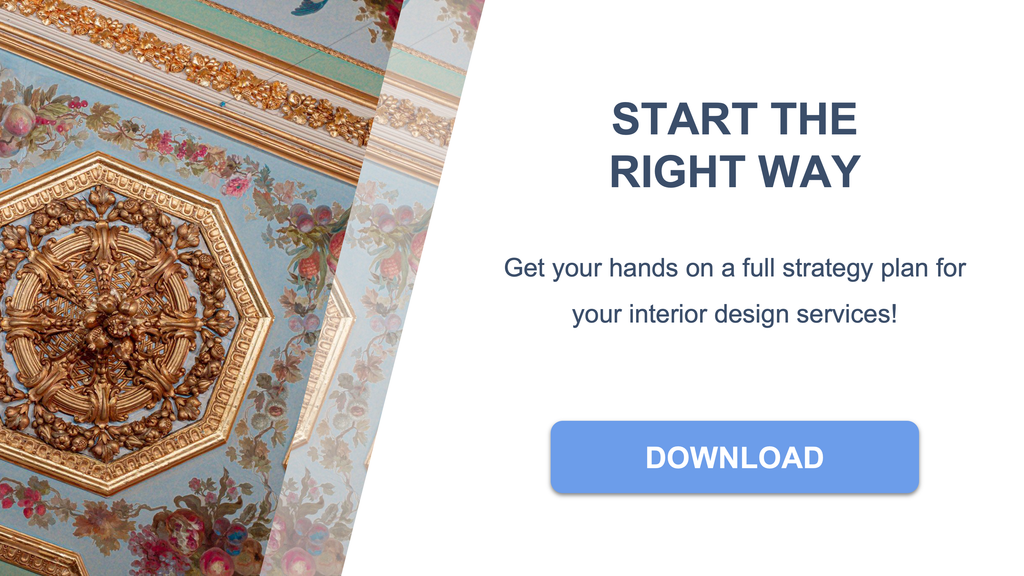
How to draft a great business plan for your interior design services?
A good business plan for an interior designer must reflect the unique aspects of the design industry.
To start, it is crucial to provide a comprehensive overview of the interior design market. This includes current statistics and identifying emerging trends within the industry, as illustrated in our interior design business plan template .
Then, you should articulate your business concept effectively. This encompasses your design philosophy, pinpointing your target clientele (such as homeowners, real estate developers, commercial clients), and the distinctive services you offer (residential design, commercial projects, sustainable design, etc.).
The next section should delve into market analysis. This requires a thorough understanding of your competitors, industry trends, and client preferences.
For an interior designer, particular emphasis should be placed on the services portfolio. Detail the range of design services you plan to provide - space planning, color consultation, furniture selection, etc. - and explain how they cater to the needs and tastes of your intended market.
The operational plan is also vital. It should outline your business location, the structure of your design studio, supplier relationships for materials and furnishings, and your project management approach.
For an interior designer, it is important to highlight your design process, project timelines, and the quality of materials and workmanship.
Then, address your marketing and sales strategy. How will you build your brand and maintain client relationships? Consider promotional tactics, client engagement, and potential value-added services (such as virtual design consultations).
Utilizing digital strategies, like a professional website or an active social media presence, is equally important in the modern marketplace.
The financial plan is another critical component. This should include your startup costs, revenue projections, operating expenses, and the point at which you will break even.
In the interior design business, project-based billing can vary widely, so it is crucial to have a thorough understanding of your pricing structure and cash flow management. For assistance, you can refer to our financial forecast for interior designers .
Compared to other business plans, an interior design business plan must pay special attention to portfolio development, client relationship management, and the creative process, which are central to the industry.
A well-crafted business plan will not only help you clarify your vision and strategy but also attract clients or secure financing.
Lenders and investors are looking for a solid market analysis, realistic financial projections, and a clear understanding of how you will manage projects and client expectations.
By presenting a detailed and substantiated plan, you showcase your professionalism and dedication to the success of your interior design business.
To achieve these goals while saving time, feel free to complete our interior design business plan template .

A free example of business plan for an interior design services
Here, we will provide a concise and illustrative example of a business plan for a specific project.
This example aims to provide an overview of the essential components of a business plan. It is important to note that this version is only a summary. As it stands, this business plan is not sufficiently developed to support a profitability strategy or convince a bank to provide financing.
To be effective, the business plan should be significantly more detailed, including up-to-date market data, more persuasive arguments, a thorough market study, a three-year action plan, as well as detailed financial tables such as a projected income statement, projected balance sheet, cash flow budget, and break-even analysis.
All these elements have been thoroughly included by our experts in the business plan template they have designed for an interior designer .
Here, we will follow the same structure as in our business plan template.
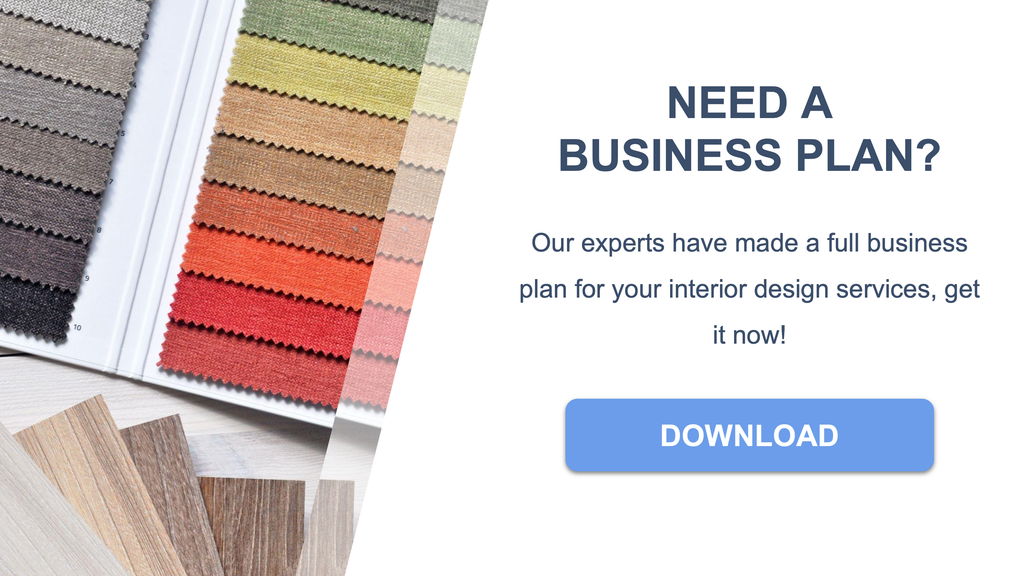
Market Opportunity
Market data and figures.
The interior design industry is a dynamic and evolving sector with significant growth potential.
Recent studies have shown that the global interior design market is expected to reach a value of over 150 billion dollars by the next few years. This growth is driven by an increasing interest in home renovation and design, fueled by real estate market trends and the desire for personalized living spaces.
In the United States, there are over 100,000 interior design businesses, generating an estimated annual revenue of over 10 billion dollars. This underscores the vital role interior design plays in the American economy and the housing industry.
The interior design industry is witnessing several key trends that are shaping the future of living spaces.
Sustainability and eco-friendly designs are at the forefront, with clients seeking materials and products that have a lower environmental impact. There is a growing demand for energy-efficient designs, green living walls, and the use of recycled materials.
Technological advancements are also influencing the industry, with virtual reality (VR) and augmented reality (AR) tools allowing clients to visualize designs before implementation. Smart home technology integration is becoming increasingly popular, as clients look for convenience and automation in their living spaces.
Minimalism continues to be a popular aesthetic, with clean lines and uncluttered spaces. However, there is also a rise in bold and expressive designs, with personalized touches that reflect the individuality of the client.
Online design services and platforms are expanding, offering more accessible and flexible design solutions to a broader audience.
Lastly, the focus on wellness has led to designs that promote health and well-being, incorporating elements like natural light, air purification, and biophilic design principles.
Success Factors
Several factors contribute to the success of an interior design business.
First and foremost, the ability to understand and translate client visions into tangible designs is crucial. A designer who can create functional, aesthetically pleasing, and personalized spaces is more likely to build a strong reputation.
Innovation and staying abreast of design trends and new materials can help an interior designer stand out in a crowded market.
Networking and building relationships with suppliers, contractors, and clients are essential for business growth and the successful execution of design projects.
Excellent communication and project management skills are also vital, ensuring that projects are completed on time, within budget, and to the client's satisfaction.
Finally, a strong online presence, through a well-designed website and active social media engagement, can help an interior designer showcase their work and attract new clients.
The Project
Project presentation.
Our interior design project is dedicated to creating personalized, functional, and aesthetically pleasing living and working spaces for clients who value a harmonious and tailored environment. Situated in a vibrant urban area, our services will cater to a diverse clientele, ranging from homeowners seeking to revamp their living spaces to businesses looking to enhance their commercial interiors.
We will focus on delivering innovative design solutions that reflect the unique style and needs of each client, ensuring that every space we design is both beautiful and practical.
Our interior design firm aspires to be recognized for its creative excellence, attention to detail, and commitment to transforming spaces into inspiring and inviting places.
Value Proposition
The value proposition of our interior design project lies in our ability to create bespoke environments that resonate with our clients' personal tastes and functional requirements.
Our dedication to understanding each client's vision and translating it into reality sets us apart, offering a seamless and enjoyable design experience. We are committed to sourcing high-quality materials, furnishings, and accessories that not only look stunning but also stand the test of time.
We aim to empower our clients by involving them in the design process, ensuring their space is a true reflection of their identity, and educating them on design principles and the latest trends.
Our firm is poised to become a cornerstone in the community, providing innovative design solutions that enhance the way people experience their surroundings.
Project Owner
The project owner is an experienced interior designer with a keen eye for detail and a passion for creating spaces that tell a story.
With a background in design and architecture, along with a strong portfolio of successful projects, the owner brings a wealth of knowledge and creativity to the table. They are dedicated to staying ahead of industry trends and continuously honing their craft to deliver exceptional design outcomes.
With a belief in the power of design to transform lives, the owner is committed to making interior design accessible and enjoyable, ensuring that each project reflects the client's personality and lifestyle.
Their commitment to design excellence and client satisfaction is the driving force behind the project, aiming to create spaces that not only look beautiful but also enhance the quality of life for those who inhabit them.
The Market Study
Target market.
The target market for this interior design business is segmented into various groups.
Firstly, there are homeowners looking to renovate or update their living spaces to reflect their personal style and enhance functionality.
Secondly, the market includes real estate developers and investors seeking professional design services to increase the marketability and value of their properties.
Additionally, commercial clients such as businesses, hotels, and restaurants require interior design services to create aesthetically pleasing and brand-aligned environments for their customers.
Lastly, collaborations with architects and contractors can be a significant market segment, as these professionals often require the expertise of interior designers to complete their projects.
SWOT Analysis
A SWOT analysis of this interior design business project highlights several key points.
Strengths include a strong portfolio showcasing diverse design styles, personalized customer service, and a network of reliable suppliers and contractors.
Weaknesses may involve the cyclical nature of the real estate market and the challenge of staying abreast of design trends and client preferences.
Opportunities can be found in leveraging social media and digital marketing to reach a broader audience, as well as in the growing trend of sustainable and eco-friendly design.
Threats might include economic downturns affecting clients' willingness to invest in design services and the competitive nature of the interior design industry.
Competitor Analysis
Competitor analysis in the interior design industry indicates a competitive landscape.
Direct competitors include other local interior designers and design firms, as well as online design services that offer virtual consultations and digital solutions.
These competitors vie for clients who value professional expertise, creativity, and the ability to transform spaces.
Potential competitive advantages include a unique design approach, exceptional project management skills, strong client relationships, and a focus on sustainable practices.
Understanding the strengths and weaknesses of competitors is crucial for carving out a unique niche and ensuring client loyalty.
Competitive Advantages
Our competitive edge lies in our personalized approach to each project, ensuring that every design reflects the client's individual needs and lifestyle.
We maintain a curated network of craftsmen and suppliers, allowing us to source unique materials and finishes that set our designs apart.
Our commitment to sustainability and eco-friendly design not only appeals to environmentally conscious clients but also represents a growing trend in the industry.
Moreover, our expertise in space planning and functionality ensures that our designs are not only beautiful but also practical and livable.
You can also read our articles about: - how to offer interior design services: a complete guide - the customer segments of an interior design services - the competition study for an interior design services
The Strategy
Development plan.
Our three-year development plan for the interior design business is designed to establish a strong market presence.
In the first year, we will concentrate on building a robust portfolio and establishing strong relationships with key clients and suppliers. We aim to become a recognized name in the local market for high-quality interior design services.
The second year will focus on expanding our services to include virtual interior design consultations and leveraging technology to enhance our design process and customer experience.
In the third year, we plan to explore collaborations with architects and property developers, positioning ourselves as the go-to experts for interior design in new developments and renovations.
Throughout this period, we will prioritize customer satisfaction, creativity, and staying ahead of design trends to ensure we provide exceptional value to our clients.
Business Model Canvas
The Business Model Canvas for our interior design business targets individuals and businesses looking to create functional and aesthetically pleasing spaces.
Our value proposition is centered around personalized design solutions that reflect our clients' tastes and needs, combined with exceptional project management to ensure a seamless process from concept to completion.
We offer our services through direct consultations, online platforms, and partnerships with home improvement stores, utilizing our key resources such as our design expertise and network of reliable contractors and suppliers.
Key activities include client consultations, design conceptualization, project management, and networking with industry professionals.
Our revenue streams are generated from design fees, project management services, and potentially from exclusive product lines in the future. Our costs are mainly associated with marketing, staffing, and operational expenses.
Find a complete and editable real Business Model Canvas in our business plan template .
Marketing Strategy
Our marketing strategy is focused on showcasing our design expertise and successful projects.
We aim to attract clients by highlighting our unique design approach and the transformative impact of our work on their spaces. Our strategy includes a strong online portfolio, engaging social media content, and before-and-after showcases of our projects.
We will also network with industry professionals and participate in local home shows and design expos to increase visibility.
Additionally, we plan to collaborate with influencers and lifestyle bloggers to reach a wider audience and establish our brand as a leader in the interior design industry.
Risk Policy
The risk policy for our interior design business focuses on mitigating risks associated with project timelines, budget management, and client satisfaction.
We will implement strict project management protocols to ensure deadlines are met and budgets are adhered to. We will also maintain open and transparent communication with our clients to manage expectations and ensure satisfaction.
Regular training and professional development will be provided to our team to keep them updated on the latest design trends and technologies.
We will also secure professional indemnity insurance to protect against any unforeseen professional liabilities. Our priority is to deliver exceptional design services while managing the risks inherent in the creative and project-based nature of our work.
Why Our Project is Viable
We are committed to establishing an interior design business that responds to the growing demand for personalized and professional design services.
With our focus on client satisfaction, innovative design solutions, and strategic market positioning, we are confident in our ability to thrive in the competitive interior design industry.
We are passionate about enhancing the spaces where people live and work and are excited to build a business that reflects our commitment to design excellence.
We are adaptable and ready to evolve with the industry, looking forward to the bright future of our interior design venture.
You can also read our articles about: - the Business Model Canvas of an interior design services - the marketing strategy for an interior design services
The Financial Plan
Of course, the text presented below is far from sufficient to serve as a solid and credible financial analysis for a bank or potential investor. They expect specific numbers, financial statements, and charts demonstrating the profitability of your project.
All these elements are available in our business plan template for an interior designer and our financial plan for an interior designer .
Initial expenses for our interior design business include costs for professional design software, a well-equipped office space, a portfolio website, sample materials for client presentations, liability insurance, and marketing efforts to establish a strong brand presence.
Our revenue assumptions are based on an in-depth analysis of the local market's demand for interior design services, factoring in trends in home renovation, real estate development, and the increasing appreciation for personalized living spaces.
We anticipate a steady growth in client engagements, starting with smaller projects and expanding to larger, more lucrative contracts as our reputation for quality and creativity grows.
The projected income statement outlines expected revenues from our design services, project costs (materials, subcontractors, travel), and operating expenses (office rent, marketing, salaries, etc.).
This results in a forecasted net profit that is essential for assessing the long-term viability of our interior design business.
The projected balance sheet reflects assets unique to our business, such as design software, office equipment, and furniture, as well as liabilities including business loans and accounts payable.
It provides a snapshot of the financial standing of our interior design firm at the conclusion of each fiscal period.
Our projected cash flow statement details the inflows and outflows of cash, enabling us to predict our financial needs at any point. This is crucial for maintaining a healthy cash balance and ensuring smooth business operations.
The projected financing plan identifies the specific sources of funding we intend to tap into to cover our initial costs.
The working capital requirement for our interior design business will be diligently tracked to guarantee we have sufficient funds to support our day-to-day activities, such as sourcing materials, managing inventory, and compensating our team.
The break-even analysis for our venture will pinpoint the volume of business we need to achieve to cover all our costs, including the initial investments, and to begin generating profits.
It will signal the point at which our business becomes financially sustainable.
Key performance indicators we will monitor include the profit margin on our design projects, the current ratio to evaluate our ability to meet short-term liabilities, and the return on investment to determine the efficiency of the capital we have invested in our business.
These metrics will assist us in gauging the financial health and overall success of our interior design enterprise.
If you want to know more about the financial analysis of this type of activity, please read our article about the financial plan for an interior design services .
- Choosing a selection results in a full page refresh.
- Opens in a new window.
Need a business plan? Call now:
Talk to our experts:
- Business Plan for Investors
- Bank/SBA Business Plan
- Operational/Strategic Planning
- L1 Visa Business Plan
- E1 Treaty Trader Visa Business Plan
- E2 Treaty Investor Visa Business Plan
- EB1 Business Plan
- EB2 Visa Business Plan
- EB5 Business Plan
- Innovator Founder Visa Business Plan
- UK Start-Up Visa Business Plan
- UK Expansion Worker Visa Business Plan
- Manitoba MPNP Visa Business Plan
- Start-Up Visa Business Plan
- Nova Scotia NSNP Visa Business Plan
British Columbia BC PNP Visa Business Plan
- Self-Employed Visa Business Plan
- OINP Entrepreneur Stream Business Plan
- LMIA Owner Operator Business Plan
- ICT Work Permit Business Plan
- LMIA Mobility Program – C11 Entrepreneur Business Plan
- USMCA (ex-NAFTA) Business Plan
- Franchise Business Planning
- Landlord Business Plan
- Nonprofit Start-Up Business Plan
- USDA Business Plan
- Cannabis business plan
- eCommerce business plan
- Online Boutique Business Plan
- Mobile Application Business Plan
- Daycare business plan
- Restaurant business plan
Food Delivery Business Plan
- Real Estate Business Plan
- Business Continuity Plan
- Buy Side Due Diligence Services
- ICO whitepaper
- ICO consulting services
- Confidential Information Memorandum
- Private Placement Memorandum
- Feasibility study
- Fractional CFO
- How it works
- Business Plan Templates
Interior Design Business Plan Example
Published May.05, 2017
Updated Apr.23, 2024
By: Noor Muhammad
Average rating 4.4 / 5. Vote count: 5
No votes so far! Be the first to rate this post.
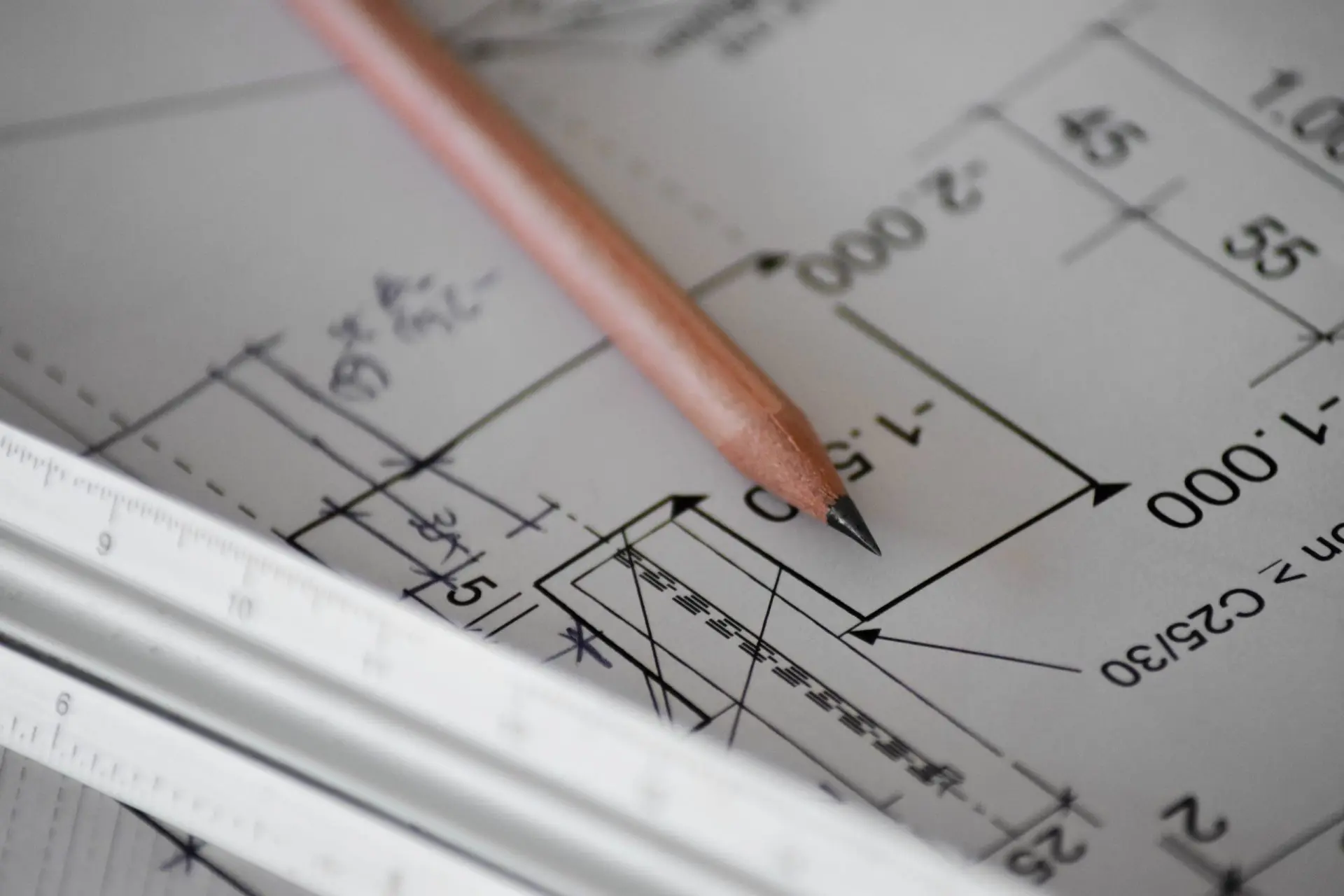
Table of Content
Do you want to start an Interior Design business plan?
Like all other businesses, starting an interior design business can be hard, no matter who tries to start it. But having an interest in the niche can get you ahead of many.
A business plan contains all the necessary details needed to start a business. All businesses start with an idea and a business plan, be it a business plan for interior design or an engineering consulting business plan .
A business plan will help you figure out all the requirements you need to fulfill to start a viable business. You can learn about the structure of a business plan online . You can also go through sample business plans related to your niche to learn all the details. You can also learn how to write a business plan for interior design by going through the sample we’ve provided below.
Executive Summary
2.1 about the business.
Pro Interior Design will be an Interior Design startup established in Montana. The main target of the business will be to provide optimal design and decoration services to the residential as well as the commercial community throughout Montana. The business will offer various services ranging from full building planning to designing small spaces.

2.2 How Will the Business be Managed?
No company can succeed without good management. Therefore, before establishing an interior design start-up business , you need to develop a management plan.
A good practice is to hire skilled managers for the task. Besides, business management software also helps conduct business operations without difficulty.
To ensure good management of all aspects of your business, you need to develop an interior design studio business plan. You can learn how to develop a good business plan through this executive summary sample business plan for interior design.
You can also get guidance regarding good business plans through plans of related niches like business plan for banking to learn about finances. In your business plan, you will need to ensure that all aspects of the business are well-planned beforehand. Your business plan interior design should include technical, financial, personnel, and marketing details to ensure a successful start of the company.
2.3 Customers of Interior Design Company
The customers of Pro Interior Design will belong to all domains, professional as well as regular. The recurring and targeted customers of the start-up will be:
- Residential Communities
- Educational Facilities
- Event Spaces
2.4 Business Target
The target of Pro Interior Design as mentioned in our interior design firm business plan pdf is to gain a 30% market share of the Montana Interior Design market within the first 2 years.
Our financial targets to meet for the first three years of our launch are displayed below:
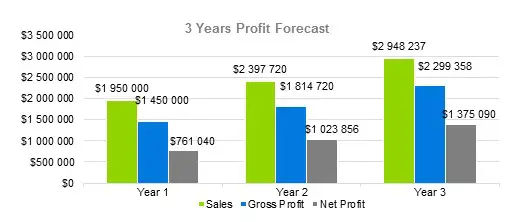
Company Summary
3.1 ownership .
Pro Interior Design will be owned and operated by Grace Ralph. Grace completed her BFA two years ago after which she worked with an architecture and design firm. However, the idea of starting her own unique brand of interior design services appealed to her. So, when she had enough capital, she decided to launch Pro Interior Designs.
3.2 Why the Interior Design company will be started
Grace wanted to provide a flexible range of services. She noticed that most interior design companies were providing services at expensive rates and they were unaffordable for small workspaces or families. She decided to provide smaller packages and individualistic services to target the often-ignored market.
3.3 How the Interior Design company will be started
Step1: Develop a Plan
To start an interior design business, you will need a business plan for an interior design firm. Business planning is crucial as it helps you combine all your operations to achieve the specific and measurable goals that you had set for the business.
To learn what components must be included in a business plan, you can take help from the interior design business plan sample pdf provided here. You can also refer to related plans like an architecture firm business plan .
Step2: Get Funding
The next step is to get the money for starting your business. When you first start a business, chances are that you will not have enough monetary resources to scale your business idea the way you need to. That is where investors come in. You can add such aspects in your business plan for an interior design company that shows financial feasibility to attract potential investors.
Step3: Pick a Location
Next, you will need to find the perfect place for your office. For Pro Interior Design, Grace decided to procure a regular office space right next to a popular florist shop in the commercial center.
Step4: Go Online
Businesses need to consider their online presence as that is where most transactions are carried out nowadays. To cater to this, Grace decided to hire a social media manager to maintain company personas on the web. She will also invest in the development of a website for basic communication with clients.
Step5: Promote and Market
Marketing is a very important aspect to ensure the success of a business. To promote the business, Grace will personally see the progress of social media managers and invest in other forms of marketing.
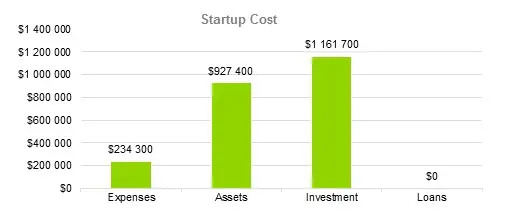
| Legal | $112,400 |
| Consultants | $0 |
| Insurance | $22,200 |
| Rent | $33,100 |
| Research and Development | $10,000 |
| Expensed Equipment | $53,200 |
| Signs | $3,400 |
| Start-up Assets | $222,400 |
| Cash Required | $201,000 |
| Start-up Inventory | $39,000 |
| Other Current Assets | $233,000 |
| Long-term Assets | $232,000 |
| Start-up Expenses to Fund | $234,300 |
| Start-up Assets to Fund | $927,400 |
| Assets | |
| Non-cash Assets from Start-up | $1,188,800 |
| Cash Requirements from Start-up | $231,000 |
| Additional Cash Raised | $50,000 |
| Cash Balance on Starting Date | $33,200 |
| Liabilities and Capital | |
| Liabilities | $11,200 |
| Current Borrowing | $0 |
| Long-term Liabilities | $0 |
| Accounts Payable (Outstanding Bills) | $53,200 |
| Other Current Liabilities (interest-free) | $0 |
| Capital | |
| Planned Investment | $1,161,700 |
| Investor 1 | $0 |
| Investor 2 | $0 |
| Other | $0 |
| Additional Investment Requirement | $0 |
| Loss at Start-up (Start-up Expenses) | $276,900 |
Whether you are starting a design business from home or not, you will need to decide on a list of services that you will provide to your customers. Deciding on the scope of services in your interior design firm business plan helps you figure out other details like finances and marketing ideas for your business.
This planning is an essential part of the business plan of any company. So, whether it is a construction company business plan or a business plan for interior design services, you will need to first decide which services you will be offering to your customers.
In this interior design business plan example, we are providing the services that will be provided by Pro Interior Design.
- Space Planning
The designers at Pro Interior Design will help you model your spaces according to your need. In this way, offices can adequately utilize the space that is available to them and families can make the most of their homes/ apartments.
- Decorative Selections
Pro Interior Design will offer customized and domain-specific decorative selections to its customers. Our designers will make your spaces alive with lighting and hardware selections.
- Furniture & Accessories
Our company will also provide a furniture and accessories selection service where our designers will offer tips and samples to customers to choose from.
- Art Selections
For our more artistic and ambiance focus customers, we will also offer the services of special art and design consultants that will help the customers in finding the best art pieces for their spaces be it an office or a room.
Marketing Analysis of Interior Design Company
Excellent work.
excellent work, competent advice. Alex is very friendly, great communication. 100% I recommend CGS capital. Thank you so much for your hard work!
Starting an interior design company can seem like a tremendous task with many complexities involved. The process becomes easier if you do a marketing analysis first. The marketing analysis helps you go through interior design business plan examples and learn how your competitors are running various operations.
You can gain in-depth insight into your target market by going through different interior designer business ideas. Afterward, when you develop your own business plan for an interior design firm. You should use your knowledge about past, present, and future market trends to shape your marketing strategy.
For this interior design marketing plan example, we are providing the market details for Pro Interior Design. You can use these as guidance for your own interior design startup business plan.
5.1 Market Trends
According to IBISWorld, the US Interior Design industry has a market size of about $17 billion with almost 120,000 businesses operating throughout the country. The industry is also expected to grow at a rate of 3.1% in this decade which means that it is prime time to open a business in this niche.
5.2 Marketing Segmentation
The target customers of Pro Interior Design according to this sample business plan interior design company are divided into the following groups:
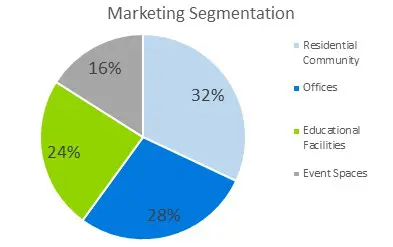
Business plan for investors
5.2.1 residential community.
Our main target customers will be the residential community of Montana. As Pro Interior design provides flexible services at both a small and large scale, these customers are expected to make use of our small-scale services the most. They are expected to utilize our designers for space planning and decorative services.
5.2.2 Offices
Our second target customers will be the small and large businesses around the area that needs to remodel their offices or want consultations regarding the design and space planning of new spaces.
5.2.3 Educational Facilities
We will also provide services to educational facilities that want to utilize their spaces to the maximum. Our trained designers will help these institutions make a space that is truly focused on learning.
5.2.4 Event Spaces
Lastly, we will also team up with event planners to provide services regarding space consultation, furniture, light, and hardware accessorizing. This will allow us to gain more regular customers in the event planning niche
| Residential Community | 32% | 43,200 | 51,840 | 62,208 | 74,650 | 89,580 | 10.00% |
| Offices | 28% | 33,200 | 39,840 | 47,808 | 57,370 | 68,844 | 10.00% |
| Educational Facilities | 24% | 27,200 | 32,640 | 39,168 | 47,002 | 56,402 | 10.00% |
| Event Spaces | 16% | 21,200 | 25,440 | 30,528 | 36,634 | 43,960 | 11.00% |
| 10% |
5.3 Business Target
- To become one of the top 3 interior design startups in our city within the first year.
- To expand the range and scale of our services to cater to large projects.
- To earn a profit margin of $10k per month by the end of our second year.
- To gain customer confidence and satisfaction and maintain it above 96%.
5.4 Product Pricing
Our prices will be much less as compared to our competitors in the market because we offer a larger range of small-scale services for homes and offices. This will be a significant advantage for Pro Interior Design in the market.
Marketing Strategy
While writing a business plan interior design, you need to focus a lot on your marketing strategies as they stand to be the difference between a business that is successful and one that is not. A marketing plan should be included in your interior design business plan company description before you arrange for establishing the business in a physical location.
And just like a real estate flipping business plan , your business plan interior design company should also include details about how you will market your services.
Below, we are presenting the marketing plan for an interior design business called Pro Interior Design:
6.1 Competitive Analysis
- We provide small-scale services for houses at a much cheaper rate.
- Our customers can communicate with us to create different packages suited to their needs.
- Our customers can get a 5% discount on all services if they register with us for a year.
- Our policies are customer-centric, we remain in touch with them through the website.
6.2 Sales Strategy
- We will promote our business by holding small events throughout the city.
- We will use social media platforms to get the word out
- We will offer a 30% discount to the first 50 customers.
6.3 Sales Monthly
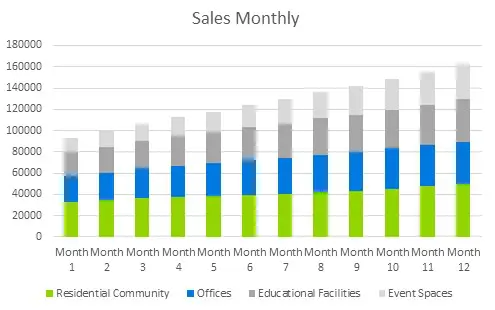
6.4 Sales Yearly
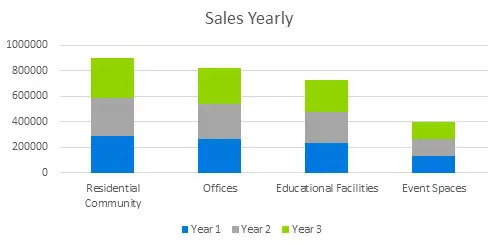
6.5 Sales Forecast
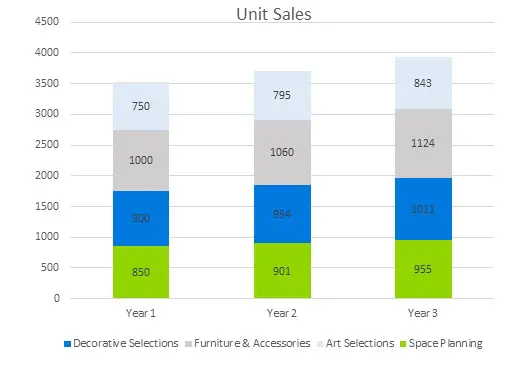
| Unit Sales | |||
| Space Planning | 850 | 901 | 955 |
| Decorative Selections | 900 | 954 | 1,011 |
| Furniture & Accessories | 1,000 | 1,060 | 1,124 |
| Art Selections | 750 | 795 | 843 |
| Unit Prices | Year 1 | Year 2 | Year 3 |
| Space Planning | $500.00 | $580.00 | $672.80 |
| Decorative Selections | $750.00 | $870.00 | $1,009.20 |
| Furniture & Accessories | $550.00 | $638.00 | $740.08 |
| Art Selections | $400.00 | $464.00 | $538.24 |
| Sales | |||
| Direct Unit Costs | Year 1 | Year 2 | Year 3 |
| Space Planning | $100.00 | $110.00 | $115.50 |
| Decorative Selections | $250.00 | $275.00 | $288.75 |
| Furniture & Accessories | $100.00 | $110.00 | $115.50 |
| Art Selections | $120.00 | $132.00 | $138.60 |
| Direct Cost of Sales | |||
Personnel plan
One of the essential keys to learning how to run a successful interior design business is to hire a good workforce. Well-suited employees can help your business boom. Especially, in a business in which sales depend on direct interaction between people and customers, the qualifications, skillset, and behaviors of employees become all the more important. To have an idea of what staff is usually hired in such businesses, you can go through remodeling business plan or an interior design company business plan pdf like the one shown here.
7.1 Company Staff
- 1 Co-Manager to help in overall operations
- 5 Certified Designers
- 2 General Cleaners
- 2 Sales Executives to handle social media and website
- 1 Accountant
- 1 Receptionist
7.2 Average Salary of Employees
| Manager | $30,000 | $33,000 | $36,300 |
| Designers | $160,000 | $176,000 | $193,600 |
| Cleaners | $40,000 | $44,000 | $48,400 |
| Sales Executives | $42,500 | $46,750 | $51,425 |
| Accountant | $23,500 | $25,850 | $28,435 |
| Drivers | $23,500 | $25,850 | $28,435 |
| Receptionist | $23,500 | $25,850 | $28,435 |
Financial Plan
To ensure that your business is a success, you will need to develop a financial plan for an interior design business. A good financial plan should include a detailed analysis of the price of your products, your sales, and the profit earned against each sale.
Moreover, a comprehensive financial plan should include 3-year projections of break-even analysis, business ratios, balance sheet, etc. to help you direct your finances in a better way.
In this interior design firm business plan pdf, we are detailing the financial plan for Pro Interior Design. You can also refer to other business plans like HVAC business plan to find out what you should add to your financial plan.
8.1 Important Assumptions
| Plan Month | 1 | 2 | 3 |
| Current Interest Rate | 8.12% | 8.20% | 8.26% |
| Long-term Interest Rate | 8.40% | 8.44% | 8.47% |
| Tax Rate | 24.03% | 24.21% | 24.60% |
| Other | 0 | 0 | 0 |
8.2 Break-even Analysis
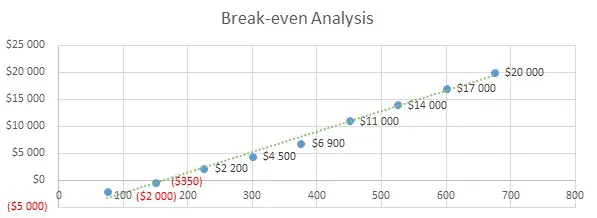
| Monthly Units Break-even | 5340 |
| Monthly Revenue Break-even | $132,500 |
| Assumptions: | |
| Average Per-Unit Revenue | $231.00 |
| Average Per-Unit Variable Cost | $0.62 |
| Estimated Monthly Fixed Cost | $163,800 |
8.3 Projected Profit and Loss
| Other | $0 | $0 | $0 |
| TOTAL COST OF SALES | |||
| Expenses | |||
| Payroll | $319,500 | $351,450 | $386,595 |
| Sales and Marketing and Other Expenses | $145,000 | $148,000 | $156,000 |
| Depreciation | $2,300 | $2,350 | $2,500 |
| Leased Equipment | $0 | $0 | $0 |
| Utilities | $2,900 | $3,000 | $3,100 |
| Insurance | $2,100 | $2,100 | $2,100 |
| Rent | $2,900 | $3,000 | $3,200 |
| Payroll Taxes | $24,000 | $25,000 | $27,000 |
| Other | $0 | $0 | $0 |
| Profit Before Interest and Taxes | $951,300 | $1,279,820 | $1,718,863 |
| EBITDA | $951,300 | $1,279,820 | $1,718,863 |
| Interest Expense | $0 | $0 | $0 |
| Taxes Incurred | $190,260 | $255,964 | $343,773 |
| Net Profit | $761,040 | $1,023,856 | $1,375,090 |
| Net Profit/Sales | 39.03% | 42.70% | 46.64% |
8.3.1 Profit Monthly
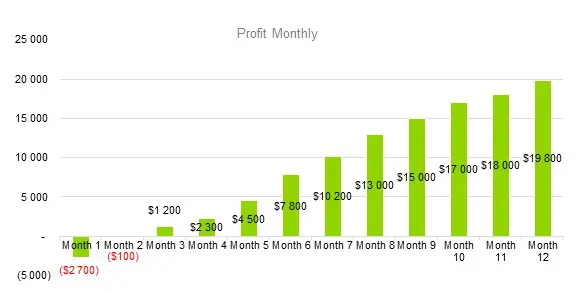
8.3.2 Profit Yearly
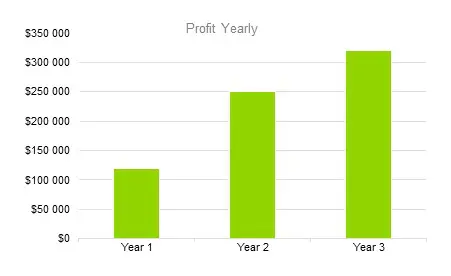
8.3.3 Gross Margin Monthly
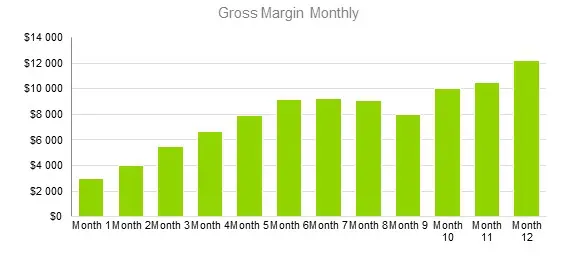
8.3.4 Gross Margin Yearly
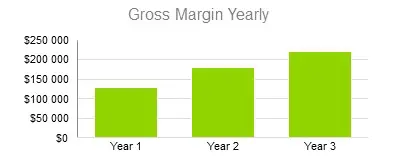
8.4 Projected Cash Flow
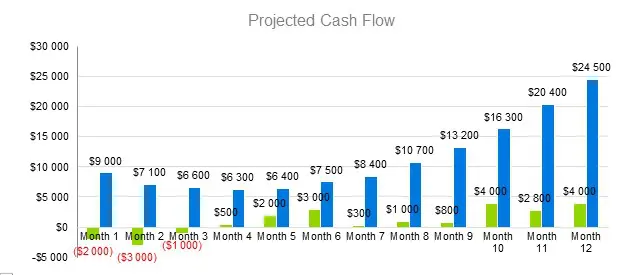
| Cash Received | |||
| Cash from Operations | |||
| Cash Sales | $51,000 | $55,080 | $59,486 |
| Cash from Receivables | $22,000 | $23,760 | $25,661 |
| SUBTOTAL CASH FROM OPERATIONS | |||
| Additional Cash Received | |||
| Sales Tax, VAT, HST/GST Received | $0 | $0 | $0 |
| New Current Borrowing | $0 | $0 | $0 |
| New Other Liabilities (interest-free) | $0 | $0 | $0 |
| New Long-term Liabilities | $0 | $0 | $0 |
| Sales of Other Current Assets | $0 | $0 | $0 |
| Sales of Long-term Assets | $0 | $0 | $0 |
| New Investment Received | $0 | $0 | $0 |
| SUBTOTAL CASH RECEIVED | |||
| Expenditures | Year 1 | Year 2 | Year 3 |
| Expenditures from Operations | |||
| Cash Spending | $42,000 | $42,000 | $45,000 |
| Bill Payments | $27,000 | $28,000 | $31,000 |
| SUBTOTAL SPENT ON OPERATIONS | |||
| Additional Cash Spent | |||
| Sales Tax, VAT, HST/GST Paid Out | $0 | $0 | $0 |
| Principal Repayment of Current Borrowing | $0 | $0 | $0 |
| Other Liabilities Principal Repayment | $0 | $0 | $0 |
| Long-term Liabilities Principal Repayment | $0 | $0 | $0 |
| Purchase Other Current Assets | $0 | $0 | $0 |
| Purchase Long-term Assets | $0 | $0 | $0 |
| Dividends | $0 | $0 | $0 |
| SUBTOTAL CASH SPENT | |||
| Net Cash Flow | $21,000 | $23,000 | $25,000 |
| Cash Balance | $27,000 | $30,000 | $33,000 |
8.5 Projected Balance Sheet
| Assets | |||
| Current Assets | |||
| Cash | $275,000 | $308,000 | $338,800 |
| Accounts Receivable | $24,000 | $26,880 | $30,213 |
| Inventory | $4,300 | $4,816 | $4,900 |
| Other Current Assets | $1,000 | $1,000 | $1,000 |
| TOTAL CURRENT ASSETS | |||
| Long-term Assets | |||
| Long-term Assets | $10,000 | $10,000 | $10,000 |
| Accumulated Depreciation | $19,400 | $21,728 | $24,444 |
| TOTAL LONG-TERM ASSETS | |||
| TOTAL ASSETS | |||
| Liabilities and Capital | Year 4 | Year 5 | Year 6 |
| Current Liabilities | |||
| Accounts Payable | $18,700 | $20,944 | $23,541 |
| Current Borrowing | $0 | $0 | $0 |
| Other Current Liabilities | $0 | $0 | $0 |
| SUBTOTAL CURRENT LIABILITIES | |||
| Long-term Liabilities | $0 | $0 | $0 |
| TOTAL LIABILITIES | |||
| Paid-in Capital | $30,000 | $30,000 | $31,000 |
| Retained Earnings | $53,000 | $57,770 | $63,547 |
| Earnings | $193,400 | $210,806 | $231,887 |
| TOTAL CAPITAL | |||
| TOTAL LIABILITIES AND CAPITAL | |||
| Net Worth | $293,400 | $319,806 | $351,787 |
8.6 Business Ratios
| Sales Growth | 7.25% | 8.03% | 8.90% | 3.00% |
| Percent of Total Assets | ||||
| Accounts Receivable | 9.21% | 10.20% | 11.31% | 9.80% |
| Inventory | 5.39% | 5.97% | 6.62% | 9.90% |
| Other Current Assets | 2.11% | 2.34% | 2.59% | 2.40% |
| Total Current Assets | 149.80% | 151.00% | 152.00% | 158.00% |
| Long-term Assets | 11.55% | 11.60% | 11.64% | 12.00% |
| TOTAL ASSETS | ||||
| Current Liabilities | 4.90% | 4.94% | 4.98% | 4.34% |
| Long-term Liabilities | 0.00% | 0.00% | 0.00% | 0.00% |
| Total Liabilities | 7.59% | 7.65% | 7.72% | 7.38% |
| NET WORTH | ||||
| Percent of Sales | ||||
| Sales | 100.00% | 100.00% | 100.00% | 100.00% |
| Gross Margin | 94.60% | 97.15% | 99.87% | 99.00% |
| Selling, General & Administrative Expenses | 93.56% | 96.09% | 98.78% | 97.80% |
| Advertising Expenses | 1.52% | 1.56% | 1.60% | 1.40% |
| Profit Before Interest and Taxes | 41.50% | 42.62% | 43.81% | 33.90% |
| Main Ratios | ||||
| Current | 34 | 35 | 36 | 32 |
| Quick | 33 | 33.8 | 34.645 | 33 |
| Total Debt to Total Assets | 0.18% | 0.18% | 0.17% | 0.40% |
| Pre-tax Return on Net Worth | 74.08% | 74.89% | 75.00% | 75.00% |
| Pre-tax Return on Assets | 96.30% | 101.12% | 106.17% | 111.30% |
| Additional Ratios | Year 1 | Year 2 | Year 3 | |
| Net Profit Margin | 33.56% | 34.60% | 35.67% | N.A. |
| Return on Equity | 55.80% | 57.53% | 59.31% | N.A. |
| Activity Ratios | ||||
| Accounts Receivable Turnover | 7.7 | 7.8 | 7.8 | N.A. |
| Collection Days | 100 | 100 | 100 | N.A. |
| Inventory Turnover | 32.4 | 34.02 | 35 | N.A. |
| Accounts Payable Turnover | 15.6 | 16 | 16.3 | N.A. |
| Payment Days | 27 | 27 | 27 | N.A. |
| Total Asset Turnover | 2.5 | 2.5 | 2.6 | N.A. |
| Debt Ratios | ||||
| Debt to Net Worth | -0.04 | -0.03 | -0.04 | N.A. |
| Current Liab. to Liab. | 1 | 1 | 1 | N.A. |
| Liquidity Ratios | ||||
| Net Working Capital | $244,000 | $257,664 | $272,093 | N.A. |
| Interest Coverage | 0 | 0 | 0 | N.A. |
| Additional Ratios | ||||
| Assets to Sales | 0.85 | 0.87 | 0.89 | N.A. |
| Current Debt/Total Assets | 1% | 0% | 0% | N.A. |
| Acid Test | 29 | 29.12 | 29.16 | N.A. |
| Sales/Net Worth | 2.1 | 2.2 | 2.2 | N.A. |
| Dividend Payout | 0 | 0 | 0 | N.A. |
- How do I start my own interior design business?
You can start your own interior design business by thoroughly researching your idea and developing an interior design business plan sample to present to prospective investors.
- What are the 7 elements of interior design?
The business ideas for interior designers are based on the 7 main elements of interior design which are:
- How do Interior Designers get clients?
Interior designers can either work for big architectural and design firms or freelance as consultants. And once they have enough clients, they can also start their own businesses with the help of an interior design business plan.
- What are the types of markets for interior design?
Interior design has a very vast market as most professional spaces need to be properly designed. Nowadays, people also prefer to hire design consultants to help with their homes. In this interior design firm business plan pdf, you can see the marketing segmentation part for greater detail.
Download interior design business plan sample in pdf
OGSCapital’s team has assisted thousands of entrepreneurs with top-rate business plan development, consultancy and analysis. They’ve helped thousands of SME owners secure more than $1.5 billion in funding, and they can do the same for you.
Real Estate
Export/Import
Manitoba MPNP Visa Business Plan (Canada)
Nova Scotia NSNP Visa Business Plan (Canada)
British Columbia BC PNP Visa Business Concept (Canada)
Self-Employed Visa Business Plan (Canada)
Start-Up Business Visa (Canada)
E1 Visa Business Plan (USA)
Lamp Business Plan for Bank Loan
Pitch Deck Marketing Agency
L1 Visa Business Plan (USA)
E2 Visa Business Plan (USA)
Franchise Business Plan
Maeme’s Franchise Business Plan
Subway Franchise Business Plan
Pitch Deck Sport Wear
Cannabis Business Plan PDF
Ecommerce Business Plan PDF
EB2 NIW visa Business Plan
EB-1 Business Plan
Cananabis Pitch Deck Sample
StartUp Visa Business Plan (UK)
Start Up Visa Business Plan (Canada)
Real Estate Business Plan Sample
Innovator Visa Business Plan Sample (UK)
Cannabis Business Plan Sample
Intra-Company Transfer (ICT) Work Permit Business Plan
OINP Program Business Plan
LMIA Business Plan Canada

Business Plan for Mentoring Program

Business Continuity Plan for Manufacturing

Business Plan for Potato Chips

Sourcing and Fulfillment Business Plan

Business Plan for Sheep Farming

Business Plan for Sole Proprietor

Any questions? Get in Touch!
We have been mentioned in the press:
Leave a Reply Cancel reply
Your email address will not be published. Required fields are marked *
Save my name, email, and website in this browser for the next time I comment.
Search the site:
How To Start An Interior Design Business: 15 Steps To Launch
15 Mins Read
November 10th, 2021

Jump ahead to:
Interior Design Business
Interior design is a work of art. Sure it may not be about picking up a brush or a guitar, or any conventional art form that we revere but putting together an entire house to reflect the personality of the homeowner is nothing short of talent. When you have an innate gift from God to do something better than everyone, you cannot let it go to waste.
Most interior design firms hire these talented artists because they see more potential in them than the interior designers do in themselves. While working for a firm offers exposure and definitely first-hand knowledge into the interior design industry, there is more to it.
If you have the talent and the confidence to make it on your own, then do it. Create a viable business plan and start your own interior design business to show the world what you’re really capable of. These days, entrepreneurs all but grow on trees. If they can do it, so can you.
Of course, there is a bit of planning and a requirement to work out the kinks of a startup. That’s what we are here to help you do. Today, we will discuss the steps you need to take in order to launch your small business and take it to new heights. We will lay out the plan so you can live your dream.
Are you ready?
Read also – 10 Essential Tools for Interior Designers

Image Credit: krofficeinteriors.com
How to start a successful interior design business?
Now, before we move on to the steps, we just want to share one thing. If you’ve come this far seeking a way to launch your own interior decorating firm then you already recognize your potential. Don’t turn back. We understand that inaugurating a new business can be scary and make you feel off-balance but if something scares you, that means you want it badly. It is only the fear of failure that’s blocking you, not your talent.
Use these steps and tips to methodically fulfill your dreams despite what society or your fear might be telling you. So, let’s get started:
1. Work on your portfolio
If you have the opportunity to work with an already established interior design firm before you start your own business then take the opportunity to build your portfolio . Select the best and most outstanding design projects you have ever created and put them into a presentation format.
If, on the other hand, you are a fresh new graduate with an excellent eye for design but no former experience, you can use software programs. Foyr Neo is a personal favorite to several interior design professionals and students alike due to its user-friendly interface and cloud-based platform. Use the technology they offer to your advantage.
You can select different layouts and build a portfolio of your design ideas. You can even create mood boards and 3D presentations to impress new clients with your design work.
A portfolio is what potential clients will see before they hire your interior design services. Therefore, you need to put your best foot forward and plan it out precisely.
Read also – 16 Interior Design Rules Every Interior Designer Should Follow
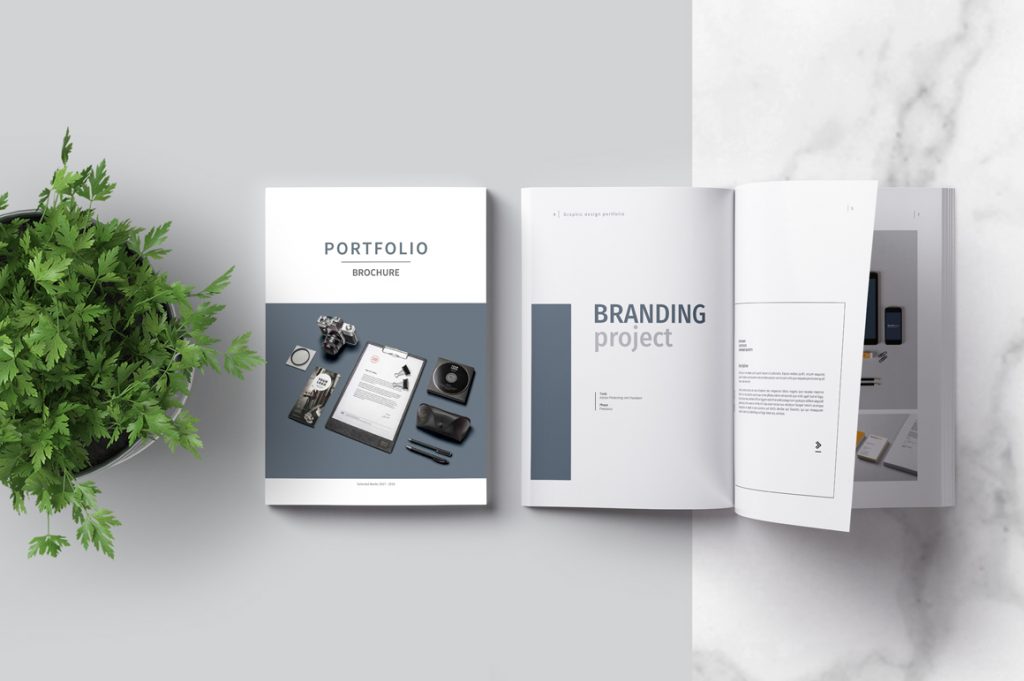
Image Credit: pinterest.com
2. Identify your USP
Every interior designer has a personal style and themes that they prefer. Maybe you like modern architecture and design, perhaps you’re inclined towards classic combinations of elegance and antiques, or maybe you are good with wicker and rustic themes.
It is important to identify your unique selling point; the design style you excel at that no one else can touch you with a ten-foot pole.
Create new interior design ideas to dominate a floor plan that design clients find most attractive. You don’t have to delve into every design style if they don’t appeal to you. Identifying your USP will help find the right target market, thereby making you a success in your own right.
Read also – 20 Common Interior Design Mistakes To Avoid
3. Perfect your skills at using interior design software
Interior design software programs are your new best friends. Find one that is easy to use and offers multiple horizons to explore.
Foyr Neo is the top-rated interior design software that offers different floor plans to choose the square foot of a layout an array of color palettes, furnishing, mood boards, and templates. You can create a new interior design on a cloud-based platform, which means you will always have access to them even if your computer breaks down or you lose your phone. The software also offers 3D models and visualization that helps design clients envision all your design work in real-time scenarios.
Use these techniques to create mind-blowing design work with a clear vision. Once you master the interior design software programs, you can build anything your client desire with finesse and appeal.
Read also – How To Learn Interior Design Software?

4. Decide on the interior design services that you wish to offer
As we have said before, you don’t need to cater to the overall market. Choose your interior design services based on what you excel at.
If you are good at designing commercial buildings then offer services applicable to office spaces. If you’re good at home decorating then you can render services for residential properties. If you so choose, you can even offer to decorate a church or an event venue.
Once you identify the type of properties, select the services that you are best at designing. Perhaps you have a list of custom furniture designers or deck and landscaping experts at your beck and call. Maybe you are well-connected with art dealers and auction houses. Maybe you have a solid repertoire with furniture stores that offer unique pieces. Or perhaps, you’re connected to them all.
Offer the services that you know you can do better than all your competitors. Although you can delve into an overall design scheme, your personalized services will speak mounds of your talent.
Read also – 15 Problems Most Interior Design Business Faces
5. Do you need an office?
Now, we come to the execution part. This is where you need to start your business in full swing.
Ask yourself, do you need an office space in a commercial building or do you want to start at a scaled-down level in the beginning?
If you’re starting your new business with no external aid or former experience, you can always begin your design work in your home office . Clients won’t mind visiting your home office, especially if it provides a glimpse of what you’ve done with the space in your own home. It subliminally reflects personal dedication.
If, on the other hand, you prefer an office space in a commercial building then keep in mind, you have to pay rent and utilities, so, plan accordingly.
If your business plan is flawless then no one cares where you set up shop as long as you render top-notch interior design services.
6. Select a prominent business name and get business cards
This is an important aspect of any business. You need to select a name that will not only clue ideal clients about your excellence but also reflect your personality.
A lot of designers tend to use their own name to build a brand , which shows confidence and sets them apart from their competitors. Other interior design professionals choose business names that represent a faceless brand. This is also a welcome technique if you plan on hiring designers and expanding your horizons as business owners.
The name of your business is pivotal because when you apply for credit cards and financial aid, it helps separate the commercials of your business from your personal account. The stakeholders will partake in financials when you expand. However, if you use your own name, the line between professional and personal tends to cinch considerably.
If you’ve selected your business name, register it. You don’t want competitors beating you to the punch. This registration is a precursor to what comes next but before that, don’t forget to print out business cards.
A business card tells the client at a glance that you have established a legitimate operation with a genuine business email and a location of operations. You can add your business contact along with important links embossed on the card. Soon you’ll know the true purpose of the card too, we promise.
Read also – How To Become An Interior Designer?

Image Credit: 1800businesscards.com
7. Apply for a business license
Once you have the business name in place, you need to apply for a license. No trade is valid without an authentic business license whether you work from the comfort of your own home or in a startup office space. Trust us when we say that the sum you invest in licensure is thrifty compared to the huge fines you’ll have to pay if the IRS comes knocking.
So, to get started, you need to register your business name and apply for a license. You probably already have an interior decorating license from the board but this is a trade license. They are very different.
Your license to practice allows you to legally work for any firm and offer your exquisite insight. However, a trade or business license registers you as an independent business owner or a company that is allowed to transact financials separately in the name of the brand. Your personal finances have nothing to do with it.
The business license is also further proof to potential clients that you are legit and won’t run away with their down payments leaving them high and dry. It also allows you to participate in trade shows and exhibitions where you can seek new clients and customers .
Read also – Financial Management for Interior Design Business
8. Create an online presence
Every brand needs an online presence. It is the face of the company that any interested party is going to see before they approach you.
Now, we have discussed making a portfolio presentation. However, if you think about it, not all design clients will offer you the opportunity to share a PPT file or a large book. You can’t even carry that binder around wherever you go and you may inadvertently lose potential clients in the process.
We have a solution to that.
Build a website. Use your business name as the domain and create your online presence on the World Wide Web, which is literally accessible worldwide.
When you have a website at the ready, there is more than one way to impress clients with your innate talents and design eye. You can simply hand over your business card with the website address. Clients will find your approach non-aggressive and professional.
There on, it is up to them to check out your website and discover your services for themselves. A well-built website reflects the business owner’s attention to detail and their ability to design just about anything.
If you don’t want to spend a lot of money on a new website with servers and online securities, you can simply opt for some of the free or low-cost options available. There’s WordPress which offers various templates and fonts along with multiple pages or you can opt for other similar options. Once you have the finances to support it, you can make the website independent for a small fee.
The best part about these website builders is they use shared server systems thus reducing your overhead technical costs.
You can design the website however you like. They can reflect your design work while subliminally influencing clients to hire your interior decorating business for their specialized needs.
Read also – Client Presentation for Interior Designers

Image Credit: searchfit.com
9. Decide on your design fees, both base rate, and additional charges
You need to have a definitive price in mind for your design services.
Start by determining a flat fee. This is the amount that you will charge for consultations, whether or not the client moves ahead with the design project. It is a sort of insurance so clients don’t consult with you for free, get the required information, and then turn around and hire cheaper designers who will execute your plan. You get paid for any services rendered including a simple consultation.
Next, you have the variable charges. These are highly reliant on the amount of work that needs to be done, the crew you will hire, the acquisition of various raw materials, furniture, etc., and the labor time.
Lastly, you need to have a set design fee . This is again contingent on any altercations that the client may raise after you start the design process. It keeps your business protected against losses.
You can print out a tariff for all the components of your design fee and let the clients decide for themselves. Think of it as a filter wherein you don’t waste precious time with potential clients who are on the fence or simply window-shopping. It will help save time to address the issues of ideal clients with who you can share mutual benefits wherein you do the work and they provide references for more projects.
Read also – Pricing Strategy for Interior Designers
10. Identify your target market and start promoting
Your target market makes for ideal clients. You need to identify what kind of demographics you want to cater to.
If your design style focuses on exquisite antiques and elegant designer pieces, then your target market is high-end. If you want to target the middle-class population then your design work must include beautiful woodwork and pleasant aesthetics at a fair price.
The target market also helps you determine what kind of network you need to build and your design fees.
11. Build relationships and network as much as possible
Networking is the root of success for all businesses alike. Interior design is no exception.
Build relationships with real estate agents and websites for recommendations. Their clients are always looking for interior decorators so, make sure you are on top of their list.
Subsequently build good relations with people working at art galleries, antique auction houses, furniture designers, suppliers for raw materials, and other items that you know you will need to execute your design plans. These connections will help you acquire the necessary materials, wall art, and home decor as per your client’s expectations.
If you wish, you can always make a profit in these regards while bringing your client’s vision for their dream home to life.
Also, build relationships with architectural firms and contractors. You can not only land huge projects but also hire an efficient labor force at a reasonable cost based on your client’s budget.
Another important aspect of networking is to secure new clients. You never know where you might come across someone looking for a home remodel. You can simply hand them your business card with the company profile and website for further discussions.
Read also – Best Interior Design Communities

12. Who is taking care of bookkeeping? Do you need staff?
Now that the basics of your business are set up, consider the manpower. Do you believe you can handle the entire design process unilaterally or do you need staff?
You can always start by yourself or with a small team who can help you with the design work and execution. If you’re not well-versed with technology, you may need to hire someone who can develop the website with appropriate security.
Then there is accounting. It is ideal to hire someone who is professionally equipped with thorough knowledge in bookkeeping. There are several apps that can simplify the process too so if you wish to create a one-man army then perhaps look into these applications.
New business owners have to wear several hats at the beginning for their company to gain recognition. If you can learn all the processes yourself, then do it. Otherwise, you can hire staff.
Read also – How To Raise Funds for Your Interior Design Business?

Image Credit: mdtaxattorney.com
13. Hustle for New Clients
No one is going to come knocking at your door unless you put in the hard work. You need to develop an efficient marketing strategy and deploy several promotions.
The start of a new business is when you need to hustle. Put in the long hours to plan, strategize, and do the work. Socializing with friends for entertainment needs to take a back seat when you want to establish your brand.
Just keep up your work till you can hire other people to manage the quirks. Even then, don’t stop hustling if you want your business to be successful.
Read also – How Do Designers Get Interior Design Clients On A Low Budget?
14. Collect testimonials and referrals
Once you have one or more satisfied clients, ask for testimonials to post on your website. The feedbacks help other clients determine whether or not you are the right fit for their interior design needs.
Another thing is, a new business flourishes on ‘word of mouth.’ Don’t shy away from requesting satisfied clients, friends, family, potential network , and in general, people you know for referrals. They can recommend your business to other people and the simple idea of having someone endorse a brand they know goes a long way into enticing potential customers. It plays on human psychology that if someone is commending your work that means there is value to it.
15. Create blogs and social media posts
These days, having an online presence for a brand is more important than the brand itself.
People are constantly seeking validation, reviews, and quality control from strangers. Use this to your advantage by building a constant presence across social media channels and blog posts.
For starters, the blogs go on the website. This is a place where you can share the basic concepts of interior design , the need to customize one’s home space, design tips, and just about anything else that you like. Make sure that the blogs are related to your business though and use appropriate SEO keywords.
The reason for this move is to make sure that whenever a client uses search engines to look for various interior design businesses, your website remains in the top searches. It is a marketing strategy that requires minimal costs.
Next, you must accumulate a few design ideas and create a series of social media posts. These serve to remind potential clients that you’re still the top designers in your business. You can also opt for social media promotions to attract new clients from other regions. These social media channels optimize the protocols as per the demographics of your target audience and pop up on their screen when they least expect it. However, they serve to entice clients into considering a remodel for their home or office, or wherever else they need a change.
Read also – 12 Digital Marketing Strategies for Interior Designers

The steps mentioned above will definitely get you where you want to go but you must remember, your business only succeeds when you put more than what you got. Business owners, especially startup owners need to hustle. Don’t look at the time, look at your revenue and what you have to offer.
The bottom line is, if you do your best, we promise, you will soon achieve more than you dreamed of. However, none of that matters unless you get started. So, take that first step and start already.
You know the secrets. There’s nothing stopping you now.

Subscribe and follow
You might also like.
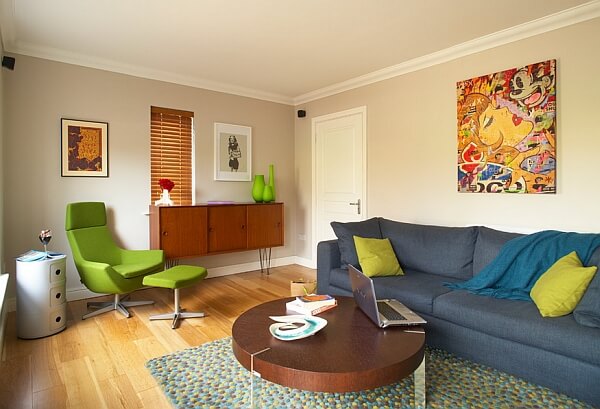
Interior Design Concepts
Modern Vs Contemporary Interior Design
February 3rd, 2024
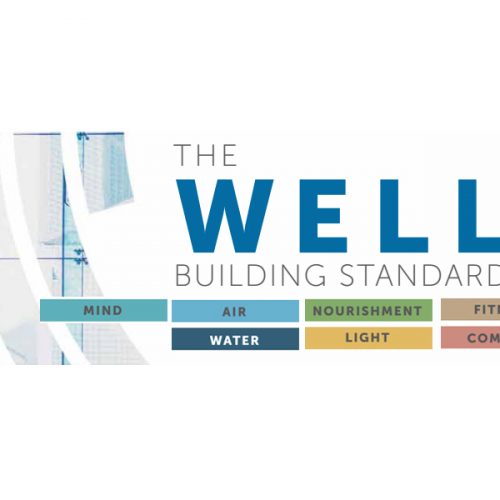
WELL Building Standard: Impact of WELL Principles on Interior Design
January 20th, 2024
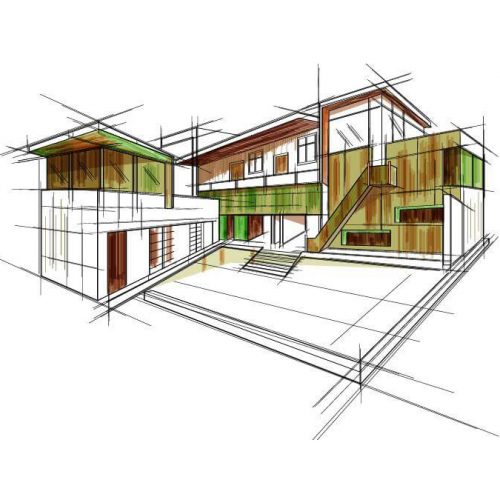
10 Best Interior Design Software Tools for Professionals
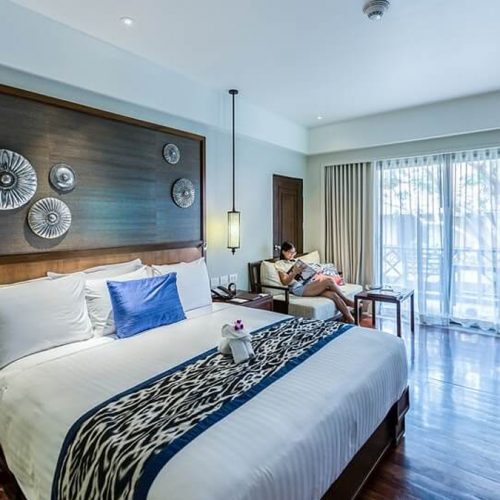
Best Home Interior Design Tips To Improve Your Home Value
January 4th, 2022
Join 50,000+ designers and teams
Using Foyr Neo is as easy as 1, 2, 3. First, upload a floor plan or create one from scratch. Then drag and drop from over 60K 3D models to fill your rooms. Lastly, just set the shot and let the AI create stunning 4K renders for you in less than 10 minutes.
No Credit Card Or Download Required

Specially built for Interior Designers
Get started for free


Interior Design Business Plan [Sample Template]
By: Author Tony Martins Ajaero
Home » Business Plans » B2C Sector
Are you about starting an interior decoration business ? If YES, here’s a complete sample interior design business plan template & feasibility report you can use for FREE to raise money .
If you have ever entered a tastefully furnished house, then you will agree that those who are skilled in the interior décor trade know sure knows what it takes to make a place really beautiful. It is no wonder that hiring an interior décor sometimes might be on the high side; this is because of the level of expertise that they bring to the table.
If you think that the idea of being called an interior designer sounds good, then you may want to try your hands on the interior décor business. Truth is that the industry is a very competitive one, but truer is the fact that the sky is too big for two birds to collide.
Suggested for You
- Pressure Washing Business Plan [Sample Template]
- Personal Concierge Business Plan [Sample Template]
- Digital Print Shop Business Plan [Sample Template]
- Hardwood Flooring Business Plan [Sample Template]
- Sandblasting Business Plan [Sample Template]
A Sample Interior Design Business Plan Template
1. industry overview.
When we talk about interior design or interior decoration, we are talking about the art or process of designing the interior and in some cases the exterior of a facility; it could be a room or building. An interior designer is a person whose job is to coordinate and manage executes such projects.
The truth is that, interior design is a multidimensional vocation that covers activities such as conceptual development, communicating with the stakeholders of a project and the management and of course the execution of the design (project as agreed).
Interior designer companies are responsible for planning the design of both living and commercial facilities; they master the craft of tuning their ideas or concept into a reality. The projects that interior designers handle can be broad in scope.
It could range from structural modifications to the selection of matching furniture, curtains or blind, wallpaper and lighting et al.
The Interior Designers industry is indeed a big industry that has experienced consistent growth and innovations over the last five years. However, the industry is projected to experience marginally better conditions over the next five years.
As long as the housing market is expected to improve strongly, there will also be corresponding growth for residential interior designers as existing home sales and housing starts make up ground over the five-year period.
So also, increase in corporate profit, growth and expansion of corporate organization will open up business opportunities of interior design companies simply because there will be need for organizations to remodel their facilities to meet up with the changing trends.
Statistics has it that the Interior Designers industry has a low level of market share concentration. For instance in 2016, the top four leading interior decoration design companies are projected to account for less than 10.0% of the industry’s total revenue. Furthermore, it is fact that market share concentration has not changed significantly in the last five years.
It is important to clearly state that the Interior Designers industry is a highly fragmented industry with thousands of players, of which only a small percentage of the players of the industry generating an annual revenue exceeding $1.0 million.
A large numbers of players in interior designer industry are self-employed simply because of the nature of the job they do and of course the low start – up capital required to start the business.
The interior design industry is indeed a very large industry and pretty much active in all the parts of the world. Statistics has it that in the united states of America alone, there are about 102,848 registered interior design companies responsible for employing about 127,467 and the industry rakes in a whooping sum of $13bn annually.
In 2014 alone, the federal government of the United States of America spent a total sum of $11,270,048 on Interior Designers. During the period in review, they awarded 437 interior design contracts to 77 interior design companies, averaging a value of $146,364 per company.
The industry is indeed a highly competitive industry and of course a growing industry with steady growth rate of 3.0 percent annually. The interior design industry is very open to any aspiring entrepreneur who has the required skills to start his or her own interior design business and of course make good money from the industry.
As a matter of fact, it was projected that over the next five years, new technology will continue to emerge that will make it easier for more players to come into the industry hence increasing the competition in the industry.
2. Executive Summary
Taffy & Tanya House of Decoration™, Inc. is a U.S based interior design company. We have been able to secure a standard and well – positioned office facility in a busy business district in Virginia Beach – Virginia. We are a world class interior design company that is set to compete in the highly competitive interior design industry not only in the United States market, but also in the global market.
Taffy & Tanya House of Decoration™, Inc. will be involved in the all aspect of interior design services such as Residential interior design services, Commercial interior design services, Merchandise sales, Interior decorating services consulting services (consulting on interior decorating matters, consulting on residential design matters, consulting on institutional design matters) and other related services.
Our business goal is to become one of the leading interior design companies in the United States and we will make sure that every graphic design jobs that leaves our studio can favorable compete with the best in the industry. Our workers are going to be selected from a pool of talented and highly creative interior designers in and around Houston – Texas and also from any part of the world especially from Milan and Paris as the business grows.
We will make sure that we take all the members of our workforce through the required trainings that will position them to meet the expectation of the company and to compete with leading interior designers in the United States and throughout the globe.
At Taffy & Tanya House of Decoration™, Inc. our client’s best interest come first, and everything we do will be guided by our values and professional ethics. We will ensure that we hold ourselves accountable to the highest standards by meeting our client’s needs precisely and completely.
We will cultivate a working environment that provides a human, sustainable approach to earning a living, and living in our world, for our partners, employees and for our clients. Taffy & Tanya House of Decoration™, Inc. is founded by Mrs. Taffy Sanders and her friend, course mate and business partner for many years Ms. Tanya Emerson.
They are both graduates from The Interior Design School London. Mrs. Taffy Sanders has an MBA from London Schools of Economics. Mrs. Taffy Sanders and Ms. Tanya Emerson worked with one of the leading interior design company in Europe before coming back to The United States to set up Taffy & Tanya House of Decoration™, Inc.
This duo is vast and well-read in the interior décor trade and so is sure to build the interior décor business from the scratch to an enviable position.
3. Our Products and Services
Taffy & Tanya House of Decoration™, Inc. was established with the aim of maximizing profits in the interior design cum real estate industry.
We want to compete favorably with the leading interior design companies in the United States which is why we have but in place a competent quality assurance team that will ensure that all our interior designs and related services rendered meet and even surpass our customers’ expectations.
We will work hard to ensure that Taffy & Tanya House of Decoration™, Inc. is not just accepted in Virginia Beach – Virginia but also nationally in the United States of America. Our products and services are listed below;
- Residential interior design services
- Commercial interior design services
- Merchandise sales
- Interior decorating services consulting services (Consulting on interior decorating matters, Consulting on residential design matters, Consulting on institutional design matters)
- Other related services like giving interior makeover to historic buildings, vehicles, such as ships and aircraft et al.
4. Our Mission and Vision Statement
- Our vision is to establish a standard interior design company whose services and brand will not only be accepted in Virginia Beach – Virginia but also all through the United States of America, but also in other parts of the world.
- Our mission is to build an interior design company that will be known to execute top notch designs and projects and to become the number one choice of real estate agencies and other stake holder in the industry.
- We want to build an interior design company that can favorably compete with other leading brands in the industry.
Our Business Structure
Taffy & Tanya House of Decoration™, Inc. is an interior design company that intend starting small in Virginia Beach, but hope to grow big in order to compete favorably with leading interior design companies in the industry both in the United States and on a global stage.
We are aware of the importance of building a solid business structure that can support the picture of the kind of world class business we want to own. This is why we are committed to only hire the best hands within our area of operations.
At Taffy & Tanya House of Decoration™, Inc., we will ensure that we hire people that are qualified, hardworking, creative, customer centric and are ready to work to help us build a prosperous business that will benefit all the stake holders (the owners, workforce, and customers).
As a matter of fact, profit-sharing arrangement will be made available to all our senior management staff and it will be based on their performance for a period of five years or more as agreed by the board of trustees of the company. In view of the above, we have decided to hire qualified and competent hands to occupy the following positions;
- Chief Executive Officer
- Creative Director
Human Resources and Admin Manager
- Sales and Marketing Executive
- Interior Designer
Client Service Executive
5. Job Roles and Responsibilities
Chief Executive Officer – CEO:
- Increases management’s effectiveness by recruiting, selecting, orienting, training, coaching, counseling, and disciplining managers; communicating values, strategies, and objectives; assigning accountabilities; planning, monitoring, and appraising job results; developing incentives; developing a climate for offering information and opinions; providing educational opportunities.
- Responsible for providing direction for the business
- Creating, communicating, and implementing the organization’s vision, mission, and overall direction – i.e. leading the development and implementation of the overall organization’s strategy.
- Responsible for signing checks and documents on behalf of the company
- Evaluates the success of the organization
Creative Director:
- Serve as project manager of the organization; works directly with employees
- Responsible for designing concepts for home makeover and facility uplifts needs for client
- Develops strategic plan by studying technological and financial opportunities; presenting assumptions; recommending objectives.
- Accomplishes subsidiary objectives by establishing plans, budgets, and results measurements; allocating resources; reviewing progress; making mid-course corrections.
- Coordinates efforts by establishing procurement, production, marketing, field, and technical services policies and practices; coordinating actions with corporate staff.
- Builds company image by collaborating with customers, government, community organizations, and employees; enforcing ethical business practices.
- Maintains quality service by establishing and enforcing organization standards.
- Maintains professional and technical knowledge by attending educational workshops; reviewing professional publications / journals; establishing personal networks; benchmarking state-of-the-art practices; participating in professional societies.
- Makes certain that production and development department perform efficiently, coordinate employee efforts, and facilitate communications between management and interior designers
- Ensures that the organization work in line with international best practices.
- Responsible for overseeing the smooth running of HR and administrative tasks for the organization
- Defines job positions for recruitment and managing interviewing process
- Carries out staff induction for new team members
- Responsible for training, evaluation and assessment of employees
- Responsible for arranging travel, meetings and appointments
- Oversees the smooth running of the daily office and factory activities.
Sales and Marketing Manager
- Manage external research and coordinate all the internal sources of information to retain the organizations’ best customers and attract new ones
- Model demographic information and analyze the volumes of transactional data generated by customer
- Identifies development opportunities; follows up on development leads and contacts; participates in the structuring and financing of projects; assures the completion of development projects.
- Writing winning proposal documents, negotiate fees and rates in line with organizations’ policy
- Responsible for handling business research, market surveys and feasibility studies for clients
- Responsible for supervising implementation, advocate for the customer’s needs, and communicate with clients
- Develop, execute and evaluate new plans for expanding increase sales
- Create new markets cum businesses for the organization
- Empower and motivates the sales team to meet and surpass agreed targets
Accountant / Cashier:
- Responsible for preparing financial reports, budgets, and financial statements for the organization
- Provides managements with financial analyses, development budgets, and accounting reports; analyzes financial feasibility for the most complex proposed projects; conducts market research to forecast trends and business conditions.
- Responsible for financial forecasting and risks analysis.
- Performs cash management, general ledger accounting, and financial reporting for one or more properties.
- Responsible for developing and managing financial systems and policies
- Responsible for administering payrolls
- Ensures compliance with taxation legislation
- Handles all financial transactions for Pick ‘a’ Brain™ Finishing School
- Serves as internal auditor for Pick ‘a’ Brain™ Finishing School
Interior Designers (4)
- Liaises with clients to determine their requirement and budget
- working to a brief, which details what the space will be used for, and finding out the client’s personal ideas and requirements
- Responsible for inspecting and surveying buildings
- Responsible for negotiating fees and setting schedules for the project
- Responsible for researching and drawing up rough plans
- Responsible for developing detailed designs and choosing materials
- Responsible for supervising the work as it is carried out.
- Responsible for preparing drafts or material based on an agreement brief.
- Researches and advice the organization on style, genre and other trendy info as it relates to interior design.
- Welcomes clients and visitors by greeting them in person or on the telephone; answering or directing inquiries.
- Ensures that all contacts with clients (e-mail, walk-In center, SMS or phone) provides the client with a personalized customer service experience of the highest level
- Through interaction with clients on the phone, uses every opportunity to build client’s interest in the company’s products and services
- Manages administrative duties assigned by the HR manager in an effective and timely manner
- Consistently stays abreast of any new information on the organizations’ products, promotional campaigns etc. to ensure accurate and helpful information is supplied to potential clients when they make enquiries
6. SWOT Analysis
Taffy & Tanya House of Decoration™, Inc. hire the services of a core professional in the area of business consulting and structuring to assist our organization in building a well – structured interior design business that can favorably compete in the highly competitive interior design industry in the United States and the world at large.
Part of what the team of business consultant did was to work with the management of our organization in conducting a SWOT analysis for Taffy & Tanya House of Decoration™, Inc. One of the reasons why we did this was to make sure that core professionals take care of identifying our core areas strength and weakness.
Here is a summary from the result of the SWOT analysis that was conducted on behalf of Taffy & Tanya House of Decoration™, Inc.;
Our core strength lies in the power of our team; our workforce. We have a team of creative and highly proficient interior designers, a team with excellent qualifications and experience in various niche areas in the interior design industry.
Aside from the synergy that exists in our carefully selected interior designers, we have a robust relationship with key stake holders in the real estate industry and of course our designs and services will be guided by best practices in the industry.
As a new interior design company in Virginia Beach – Virginia, it might take some time for our organization to break into the market and gain acceptance especially from the government and other top profile clients in the already saturated and highly competitive interior design industry; that is perhaps our major weakness. Another weakness is that we may not have the required cash to promote our business the way we would want to.
- Opportunities:
No doubt, the opportunities in the interior design industry is massive considering the number of individuals and corporate organizations acquiring new properties and would need the services of interior designers to give the facilities facelift. As a graphic design company, we are ready to take advantage of any opportunity that is available in the industry.
Just like any other business, one of the major threats that we are likely going to face is economic downturn. It is a fact that economic downturn affects purchasing / spending power. Another threat that may likely confront us is the arrival of a new interior design company in same location where our target market exist and who may want to adopt same Business model like us.
7. MARKET ANALYSIS
- Market Trends
Although there are top flight institutions where people go to study interior design, it is common to find people who don’t have formal training running their own interior design business. This is what accounts for the high numbers of sole proprietorship in the interior design industry.
Aside from on – the- job training, most interior design companies usually offer short training (could be in – house) in specific areas such as presentation skills and IT packages.
As an interior designer, you are expected to keep tab with new trends and products that are always coming up in the industry. It is a fact that most interior designers ensure that they follow the traditions or patterns that are synonymous to a region.
For instance, as an interior designer in the Arab world, your designs are expected to follow the traditions and pattern in the region so also as an interior designer operating in the Orient or in the Nordic Region or in the Caribbean or any region with strong culture, your designs are expected to conform to their traditions and patterns.
It is important to state that in recent time, for any interior design company to continue to stay in business, they must continue to come up with highly creative design and concepts.
8. Our Target Market
Before starting our interior design company, we are certain that there is a wide range of both corporate and individual clients who cannot successfully move into their new facility without hiring the services of interior designers. As a matter of fact, without the services of interior designers, the interiors of facilities won’t be as beautiful and welcoming as we can see these days.
We will ensure that we develop strategic pacts with property developers, property management companies, local builders, realtors and home improvement firms. This will give us several options to generate revenue for our company.
In view of that, we have created strategies that will enable us reach out to various corporate organizations and individual who we know can’t afford to do without our services. We have conducted our market research and survey and we will ensure that all our interior design services are well accepted in the market place.
Below is a list of the people and organizations that we have specifically market our products and services to;
- Construction Companies
- Property Development Companies
- Home Owners
- Corporate Organizations
- Realtors —for their clients’ homes
- Home Improvement Companies
- Commercial builders of office and home complexes
- Home builders associations
- Furniture stores
- Paint and wall paper stores
- Flower shops
- Real Estate Owners, Developers, and Contractors
- The Government (Public Sector)
- Religious Organizations (Church hall and other places of worship)
- Television Stations (studios and offices)
Our Competitive Advantage
No doubt the competition in the interior design industry is getting stiffer by the day-as such, you have to be highly creative and come up with appealing designs and concepts in order to survive in the industry.
The interior design industry is indeed a profitable and at the same time a highly competitive industry; it enjoys strong demand as people continue to purchase or move into new apartments and remodel old ones. Clients will only hire your services if they know that they can get nothing but the best from you.
We are quite aware that to be highly competitive in the graphic design industry means that you are not only expected to be able to deliver consistent and highly creative designs, but you must be able to meet set targets. No one would want to continue to hire your services if don’t always meet up with the target date of completion of projects.
Our competitive advantage lies in the power of our team; our workforce. We have a team of creative and highly proficient interior designers, a team with excellent qualifications and experience in various niche areas in the interior design industry.
Lastly, all our employees will be well taken care of, and their welfare package will be among the best within our category (startups interior design companies in the United States) in the industry. It will enable them to be more than willing to build the business with us and help deliver our set goals and achieve all our business aims and objectives.
9. SALES AND MARKETING STRATEGY
- Sources of Income
Every business has to identify the areas that it wants to source for the startup funds, and we are set to do same. it wants to Taffy & Tanya House of Decoration™ Inc. is established with the aim of maximizing profits in the interior design cum real estate industry and we are going to go all the way to ensure that we do all it takes to meet and surpass the expectations of all our clients.
Taffy & Tanya House of Decoration™ Inc. will generate income by offering the following interior design services and other related services;
10. Sales Forecast
One thing is certain, there would always be corporate organization and individual who would need the services of interior designers whenever they purchase new home, office facilities or moving into a new facility .
We are well positioned to take on the available market in interior design / real estate industry and we are quite optimistic that we will meet our set target of generating enough income / profits from the first six month of operations and grow our interior design company to enviable heights.
We have been able to critically examine the interior design market and we have analyzed our chances in the industry and we have been able to come up with the following sales forecast. The sales projection is based on information gathered on the field and some assumptions that are peculiar to similar startups in Virginia Beach – Virginia.
Below is the sales projection for Taffy & Tanya House of Decoration™ Inc., it is based on the location of our business and of course the wide range of our services and target market;
- First Year-: $150,000
- Second Year-: $400,000
- Third Year-: $750,000
N.B: This projection is done based on what is obtainable in the industry and with the assumption that there won’t be any major economic meltdown and there won’t be any major competitor offering same interior design services as we do within same location. Please note that the above projection might be lower and at the same time it might be higher.
- Marketing Strategy and Sales Strategy
We are not ignorant of the fact that there is stiffer competition in the interior design industry; there are loads of interior designers jostling for contracts which is why we have been able to hire some of the best marketing experts to handle our sales and marketing.
Our sales and marketing team will be recruited based on their vast experience in the real estate market and they will be trained on a regular basis so as to be well equipped to meet their targets and the overall business goal of Taffy & Tanya House of Decoration™, Inc.
Our goal is to grow Taffy & Tanya House of Decoration™, Inc. to become one of the leading interior design companies in the United States of America which is why we have mapped out strategies that will help us take advantage of the available market and grow to become a major force to reckon with not only in Virginia Beach – Virginia but also in other cities in the United States of America.
Taffy & Tanya House of Decoration™ Inch is set to make use of the following marketing and sales strategies to attract clients and win interior decoration contracts;
- Introduce our interior design company by sending introductory letters alongside our brochure to corporate organizations, realtors, religious organizations and key stake holders in the real estate industry.
- Promptness in bidding for interior design contracts from the government and other cooperate organizations
- Advertise our business in relevant business magazines, newspapers, TV stations, and radio station.
- List our business on yellow pages ads (local directories)
- Attend relevant international and local expos, seminars, and business fairs et al
- Create different packages for different category of clients in order to work with their budgets and still deliver excellent design and services
- Leverage on the internet to promote our business
- Engage direct marketing approach
- Encourage word of mouth marketing from loyal and satisfied clients
11. Publicity and Advertising Strategy
We have been able to work with brand and publicity consultants to help us map out publicity and advertising strategies that will help us walk our way into the heart of our target market. We are set to become the number one choice for both corporate clients and individual clients in the whole of the Virginia Beach and beyond which is why we have made provisions for effective publicity and advertisement of our Interior design company.
Below are the platforms we intend to leverage on to promote and advertise Taffy & Tanya House of Decoration™ Inc.;
- Place adverts on both print (newspapers and magazines) and electronic media platforms
- Sponsor relevant community based events / programs
- Leverage on the internet and social media platforms like; Instagram, Facebook , twitter, YouTube, Google + et al to promote our services
- Install our Bill Boards on strategic locations all around Virginia Beach – Virginia
- Engage in roadshow from time to time in targeted neighborhoods
- Distribute our fliers and handbills in target areas
- Contact corporate organizations and residence in our target areas by calling them up and informing them of Taffy & Tanya House of Decoration™ Inc. and the services we offer
- List our interior design company in local directories / yellow pages
- Advertise our interior design company in our official website and employ strategies that will help us pull traffic to the site.
- Ensure that all our staff members wear our branded shirts and all our vehicles and trucks are well branded with our company logo et al.
12. Our Pricing Strategy
If you are conversant with the interior design industry, you will realize that the pricing structure ranges from per hour billings to fixed fee to even per square foot billing. Most interior decoration companies adopt all the available pricing system as it applies to the nature of the job or project they are expected to execute.
At Taffy & Tanya House of Decoration™ Inc. we will adopt all the pricing system as is obtainable in the industry but we will ensure that we keep the prices of our services a little below the average market rate for all of our customers by keeping our overhead low and by collecting payment in advance from corporate organizations who would hire our services.
In addition, we will also offer special discounted rates to all our customers at regular intervals. We are aware that there are some one-off jobs or government contracts which are always lucrative; we will ensure that we abide by the pricing model that is expected from contractors or organizations that bid for such contracts.
- Payment Options
At Taffy & Tanya House of Decoration™ Inc., our payment policy will be all inclusive because we are quite aware that different people prefer different payment options as it suits them. Here are the payment options that we will make available to our clients;
- Payment by via bank transfer
- Payment via online bank transfer
- Payment via check
- Payment via bank draft
- Payment via mobile money
- Payment with cash
In view of the above, we have chosen banking platforms that will help us achieve our plans with little or no itches.
13. Startup Expenditure (Budget)
In setting up any business, the amount or cost will depend on the approach and scale you want to undertake. If you intend to go big by renting a place, then you would need a good amount of capital as you would need to ensure that your employees are well taken care of, and that your facility is conducive enough for workers to be creative and productive.
This means that the start-up can either be low or high depending on your goals, vision and aspirations for your business. The materials and equipment that will be used are nearly the same cost everywhere, and any difference in prices would be minimal and can be overlooked.
As for the detailed cost analysis for starting an interior design company; it might differ in other countries due to the value of their money. However, this is what it would cost us to setup Taffy & Tanya House of Decoration™ Inc. in Virginia Beach – Virginia, U.S;
- Business incorporating fees in the United States of America will cost – $750.
- The budget for Liability insurance, permits and license will cost – $3,500
- Acquiring an office space or warehouse that will accommodate the number of employees for at least 6 months (Re – Construction of the facility inclusive) will cost – $150,000.
- Equipping the office (computers, printers, projectors, markers, servers / internet facility, furniture, telephones, filing cabinets, and electronics) will cost – $10,000
- Amount required to purchase the needed software applications – $ 3,500
- Launching an official Website will cost – $500
- Amount need to pay bills and staff members for at least 2 to 3 months – $70,000
- Additional Expenditure such as Business cards, Signage, Adverts and Promotions will cost – $5,000
Going by the report from the market research and feasibility studies conducted, we will need about two hundred thousand (200,000) U.S. dollars to successfully set – up a medium scale but standard interior design company firm in the United States of America.
Generating Funding / Startup Capital for Taffy & Tanya House of Decoration™ Inc.
Taffy & Tanya House of Decoration™ Inc. is a business that will be owned by Mrs. Taffy Sanders and her friend, course mate and business partner for many years Ms. Tanya Emerson. They are the sole financial of the business which is why they decided to restrict the sourcing of the start – up capital for the business to just three major sources.
These are the areas we intend generating our start – up capital;
- Generate part of the start – up capital from personal savings and sale of his stocks
- Generate part of the start – up capital from friends and other extended family members
- Generate a larger chunk of the startup capital from the bank (loan facility).
N.B: We have been able to generate about $100,000 (Personal savings $85,000 and soft loan from family members $15,000) and we are at the final stages of obtaining a loan facility of $100,000 from our bank. All the papers and document has been duly signed and submitted, the loan has been approved and any moment from now our account will be credited.
14. Sustainability and Expansion Strategy
It is easier for businesses to survive when they have steady flow of business deals / customers patronizing their products and services. We are aware of this which is why we have decided to develop a various mobile apps for different clients and for different purposes. We will also work with corporate clients to help them develop customized mobile apps for their business.
We know that if we continue to come up with highly creative and unique interior designs concept and excellent job delivery for corporate organizations, government agencies and household, there will be steady flow of income for the organization.
Our key sustainability and expansion strategy is to ensure that we only hire creative, competent and selfless interior designers, create a conducive working environment and employee benefits for our staff members. In the nearest future, we will give our most dedicated and prolific employees the opportunity to be part owner of the business.
We know that if we implement our business strategies, we will achieve our business goals and objectives in record time.
Check List / Milestone
- Business Name Availability Check:>Completed
- Business Incorporation: Completed
- Opening of Corporate Bank Accounts various banks in the United States: Completed
- Opening Online Payment Platforms: Completed
- Application and Obtaining Tax Payer’s ID: In Progress
- Securing a standard office facility plus renovation of the facility: Completed
- Application for business license and permit: Completed
- Purchase of All form of Insurance for the Business: Completed
- Conducting Feasibility Studies: Completed
- Generating part of the start – up capital from the founders: Completed
- Writing of Business Plan: Completed
- Drafting of Employee’s Handbook: Completed
- Drafting of Contract Documents: In Progress
- Design of Logo for the business: Completed
- Secure trademark for our products: In Progress
- Graphic Designs and Printing of Packaging Marketing / Promotional Materials: Completed
- Recruitment of employees: In Progress
- Purchase of the Needed furniture, office equipment, software applications, electronic appliances and facility facelift: In progress
- Creating Official Website for the business: In Progress
- Creating Awareness for the business: In Progress
- Health and Safety and Fire Safety Arrangement: In Progress
- Establishing business relationship with vendors and key players in the real estate industries: In Progress
Interior Designers in the US - Market Size, Industry Analysis, Trends and Forecasts (2024-2029)
Instant access to hundreds of data points and trends.
- Market estimates from
- Competitive analysis, industry segmentation, financial benchmarks
- Incorporates SWOT, Porter's Five Forces and risk management frameworks
- PDF report or online database with Word, Excel and PowerPoint export options
100% money back guarantee
Industry statistics and trends.
Access all data and statistics with purchase. View purchase options.
Interior Designers in the US
Industry Revenue
Total value and annual change from . Includes 5-year outlook.
Access the 5-year outlook with purchase. View purchase options
Trends and Insights
Market size is projected to over the next five years.
Market share concentration for the Interior Designers industry in the US is , which means the top four companies generate of industry revenue.
The average concentration in the sector in the United States is .
Products & Services Segmentation
Industry revenue broken down by key product and services lines.
Ready to keep reading?
Unlock the full report for instant access to 30+ charts and tables paired with detailed analysis..
Or contact us for multi-user and corporate license options
Table of Contents
About this industry, industry definition, what's included in this industry, industry code, related industries, domestic industries, competitors, complementors, international industries, performance, key takeaways, revenue highlights, employment highlights, business highlights, profit highlights, current performance.
What's driving current industry performance in the Interior Designers in the US industry?
What's driving the Interior Designers in the US industry outlook?
What influences volatility in the Interior Designers in the US industry?
- Industry Volatility vs. Revenue Growth Matrix
What determines the industry life cycle stage in the Interior Designers in the US industry?
- Industry Life Cycle Matrix
Products and Markets
Products and services.
- Products and Services Segmentation
How are the Interior Designers in the US industry's products and services performing?
What are innovations in the Interior Designers in the US industry's products and services?
Major Markets
- Major Market Segmentation
What influences demand in the Interior Designers in the US industry?
International Trade
- Industry Concentration of Imports by Country
- Industry Concentration of Exports by Country
- Industry Trade Balance by Country
What are the import trends in the Interior Designers in the US industry?
What are the export trends in the Interior Designers in the US industry?
Geographic Breakdown
Business locations.
- Share of Total Industry Establishments by Region ( )
Data Tables
- Number of Establishments by Region ( )
- Share of Establishments vs. Population of Each Region
What regions are businesses in the Interior Designers in the US industry located?
Competitive Forces
Concentration.
- Combined Market Share of the Four Largest Companies in This Industry ( )
- Share of Total Enterprises by Employment Size
What impacts market share in the Interior Designers in the US industry?
Barriers to Entry
What challenges do potential entrants in the Interior Designers in the US industry?
Substitutes
What are substitutes in the Interior Designers in the US industry?
Buyer and Supplier Power
- Upstream Buyers and Downstream Suppliers in the Interior Designers in the US industry
What power do buyers and suppliers have over the Interior Designers industry in the US?
Market Share
Top companies by market share:
- Market share
- Profit Margin
Company Snapshots
Company details, summary, charts and analysis available for
Company Details
- Total revenue
- Total operating income
- Total employees
- Industry market share
Company Summary
- Description
- Brands and trading names
- Other industries
What's influencing the company's performance?
External Environment
External drivers.
What demographic and macroeconomic factors impact the Interior Designers in the US industry?
Regulation and Policy
What regulations impact the Interior Designers in the US industry?
What assistance is available to the Interior Designers in the US industry?
Financial Benchmarks
Cost structure.
- Share of Economy vs. Investment Matrix
- Depreciation
What trends impact cost in the Interior Designers in the US industry?
Financial Ratios
- 3-4 Industry Multiples (2018-2023)
- 15-20 Income Statement Line Items (2018-2023)
- 20-30 Balance Sheet Line Items (2018-2023)
- 7-10 Liquidity Ratios (2018-2023)
- 1-5 Coverage Ratios (2018-2023)
- 3-4 Leverage Ratios (2018-2023)
- 3-5 Operating Ratios (2018-2023)
- 5 Cash Flow and Debt Service Ratios (2018-2023)
- 1 Tax Structure Ratio (2018-2023)
Data tables
- IVA/Revenue ( )
- Imports/Demand ( )
- Exports/Revenue ( )
- Revenue per Employee ( )
- Wages/Revenue ( )
- Employees per Establishment ( )
- Average Wage ( )
Key Statistics
Industry data.
Including values and annual change:
- Revenue ( )
- Establishments ( )
- Enterprises ( )
- Employment ( )
- Exports ( )
- Imports ( )
Frequently Asked Questions
What is the market size of the interior designers industry in the us.
The market size of the Interior Designers industry in the US is measured at in .
How fast is the Interior Designers in the US market projected to grow in the future?
Over the next five years, the Interior Designers in the US market is expected to . See purchase options to view the full report and get access to IBISWorld's forecast for the Interior Designers in the US from up to .
What factors are influencing the Interior Designers industry in the US market trends?
Key drivers of the Interior Designers in the US market include .
What are the main product lines for the Interior Designers in the US market?
The Interior Designers in the US market offers products and services including .
Which companies are the largest players in the Interior Designers industry in the US?
Top companies in the Interior Designers industry in the US, based on the revenue generated within the industry, includes .
How many people are employed in the Interior Designers industry in the US?
The Interior Designers industry in the US has employees in United States in .
How concentrated is the Interior Designers market in the United States?
Market share concentration is for the Interior Designers industry in the US, with the top four companies generating of market revenue in United States in . The level of competition is overall, but is highest among smaller industry players.
Methodology
Where does ibisworld source its data.
IBISWorld is a world-leading provider of business information, with reports on 5,000+ industries in Australia, New Zealand, North America, Europe and China. Our expert industry analysts start with official, verified and publicly available sources of data to build an accurate picture of each industry.
Each industry report incorporates data and research from government databases, industry-specific sources, industry contacts, and IBISWorld's proprietary database of statistics and analysis to provide balanced, independent and accurate insights.
IBISWorld prides itself on being a trusted, independent source of data, with over 50 years of experience building and maintaining rich datasets and forecasting tools.
To learn more about specific data sources used by IBISWorld's analysts globally, including how industry data forecasts are produced, visit our Help Center.
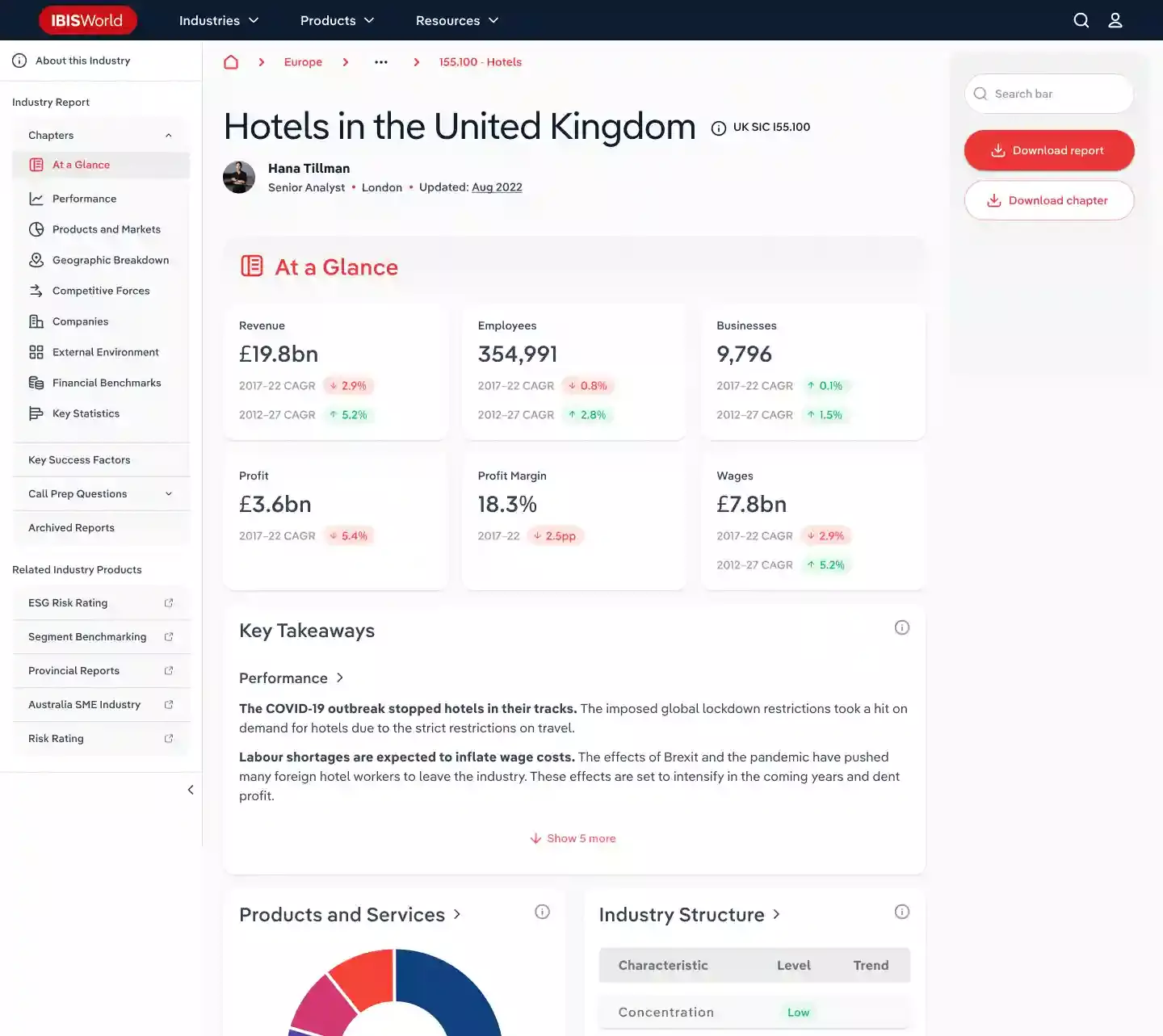
Deeper industry insights drive better business outcomes. See for yourself with your report or membership purchase.
Discover how 30+ pages of industry data and analysis can give you the edge you need..
Cafe Levantine

Review Highlights

“ Stumbled across this inviting new spot where I was delighted to find a Turkish coffee with cardamom. ” in 2 reviews
People also searched for
outdoor seating
classy food
restaurants
Location & Hours
Suggest an edit
6829 Elm St
McLean, VA 22101
Amenities and More
Ask the community.
Ask a question
Yelp users haven’t asked any questions yet about Cafe Levantine .
Recommended Reviews
The Army Is Back in the Ship Killin’ Business
A tradition as old as time.

- The U.S. Army’s new long range tactical missile sank a moving target during exercise Valiant Shield.
- This sinking marks the reintroduction of anti-ship weaponry into the Army’s vast arsenal.
- The capability to sink ships is part of the Army’s effort to become relevant in a war with China.
PrSM Strike
The strike took place towards the end of the biennial Valiant Shield multinational military exercises. Valiant Shield takes place during even-numbered years across the northern Mariana Islands, including the island of Guam, Palau, and the Mariana Island Complex. The exercises bring together the armed forces of several countries, including the United States, Japan, the Philippines, and Australia.
The strike took place on June 18th. The ex-amphibious transport dock USS Cleveland was struck by an Army Precision Strike Missile (PrSM) 40 nautical miles from land. Exercises in which decommissioned ships are attacked are known as SINKEXs, or sinking exercises. Typically, several weapons—including submarine torpedoes , anti-ship missiles, helicopter-mounted weapons, and others—are brought to bear on a decommissioned ship during a SINKEX. This allows troops to gain experience firing live weapons and allows the services to study the damage specific weapons do to ships, sometimes for the first time.
The PrSM strike was carried out by the robotic, unmanned version of the HIMARS rocket truck known as the Autonomous Multidomain Launcher, which is operated by 1-181 Artillery, Tennessee Army National Guard. PrSM is a new tactical missile, designed to replace the Cold War-era Army Tactical Missile System (ATACMS), and is designed to attack enemy targets in all weather conditions at ranges in excess of 310 miles—a distance previously made off-limits by the U.S.-Russian Intermediate Nuclear Forces treaty. The U.S. left the treaty in 2019 after accusing Russia of cheating and fielding long-range cruise missiles .
PrSM, like ATACMs, is designed to attack ground targets in the enemy’s rear, with a particular emphasis on time sensitive, moving, hardened, or fleeing targets. The missile is fired from the Army’s M270 Multiple Launch Rocket System, a heavy tracked rocket carrier, and the wheeled M142 High Mobility Artillery Rocket System, or HIMARS . A HIMARS rocket truck can carry one ATACMS missile at a time, but two PrSM missiles at the same time.
Above is a video made by PrSM’s manufacturer, Lockheed Martin, outlining how the missile works. In the video, PrSM kicks the door down for a F-35 air strike, targeting radars and surface to air missile launchers defending the target. This sort of operation is known as a multi-domain operation, and involves forces from the air and land domains to work together to carry out a common mission. Theoretically, multi-domain operations allow services to bring their own unique strengths to a mission and increse the probability of success.
In a press release , the Navy emphasized that the target ship was stripped of all chemical contaminants beforehand, describing ex-USS Cleveland as “environmentally clean.” Any target involved in a SINKEX is guaranteed to be sent to the bottom by the combined firepower of the exercise participants, and the Navy does not want pollution allegations to come back to haunt them.
The Return of the Coast Artillery

The U.S. Army has historically maintained America’s shore-based anti-ship defenses. Fort Montgomery and Fort Clinton in the Revolutionary War, Fort McHenry during the War of 1812, and the Confederate Fort Sumter during the Civil War were all manned by U.S. Army or Confederate troops (the guns were typically operated by members of the artillery branch). In 1901, the Army established the Coastal Artillery Corps —part of the Artillery branch—which manned coastal artillery guns and harbor defenses.
The Coastal Artillery Corps was disbanded in 1950, after the primacy of the U.S. Navy and its ability to meet the enemy at sea made the Army’s land-based forces obsolete . For the next 73 years, the Army was without a specific capability to attack ships. All of that changed in 2023, when the service accepted its first PrSM missile .
The Search for Relevance

The rise of the Chinese military, as well as Chinese aggression in the Western Pacific, has made a new war in the Indo-Pacific a distinct possibility. The region is dominated by the Eurasian landmass and the vastness of the Indian and Pacific Oceans. The specific areas in which China is currently trying to expand its territory—the East and South China Seas—feature very small islets, atolls, and other tiny land features bordered by major islands, including the Philippines, Japan, and other Pacific nations.
The lack of land is a problem, as the U.S. Army tries to figure out how it would contribute to a Pacific War. The Army has no amphibious forces, so seizing these small islands from an enemy would naturally go to the Marine Corps . The Army has instead decided it would contribute through brigade-sized units of long-range air defense forces and artillery units that it calls Multi-Domain Task Forces (MDTFs) , which can make life unpleasant for enemy forces within the range of their weapons. MDTFs—along with submarines, aircraft carriers, Marines, and Air Force fighters and bombers—would flood a combat zone and restrict an enemy’s ability to maneuver, conduct ambushes, and push forward into formarly occupied territory.

PrSm’s anti-ship capability is part of this scheme. Once a MDTF occupies an island, it makes an instant no-go zone with a 310 mile radius for enemy ships and aircraft . As a result, any opponent must expend the resources to suppress the MDTF or accept the risk of losing ships. If they choses the former, other air and sea forces could take advantage of the situation to hit vulnerable forces.
On one hand, the Army fielding anti-ship missiles feels like a duplication of the efforts of the Navy, Marine Corps, and the Air Force . On the other hand, excluding the Army from a future Pacific War might be a mistake, as it could limit the depth of U.S. forces available to respond to a crisis. PrSM allows the Army to create a 620-mile-wide protective bubble across the Pacific—a powerful capability that will only grow stronger as the PrSM adds range and further capabilities.

Kyle Mizokami is a writer on defense and security issues and has been at Popular Mechanics since 2015. If it involves explosions or projectiles, he's generally in favor of it. Kyle’s articles have appeared at The Daily Beast, U.S. Naval Institute News, The Diplomat, Foreign Policy, Combat Aircraft Monthly, VICE News , and others. He lives in San Francisco.

.css-cuqpxl:before{padding-right:0.3125rem;content:'//';display:inline;} Pop Mech Pro .css-xtujxj:before{padding-left:0.3125rem;content:'//';display:inline;}

Could Buried Treasure Unlock a Civil War Mystery?

The Newest X-Plane is a Quiet, Stealthy Spy Plane

Tanks With Multiple Cannons Are Having a Moment

This Million-Dollar Heist Rocked the Art World

Work-Holding Hacks

Let’s Talk About Triple Cannons

The World’s Most Powerful Tank is European

Charred Scroll Explains Plato’s Final Night
America’s Cruisers are Sailing into the Sunset
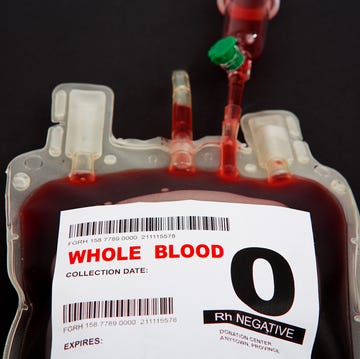
Can Young Blood Transfusions Really Reverse Aging?

Human Consciousness Is an Illusion, Scientists Say

IMAGES
VIDEO
COMMENTS
Learn the essential components and steps of writing a business plan for your interior design firm. Find out what to include in your executive summary, company overview, services, market analysis, customer analysis, marketing plan, operations plan, management plan and financial plan.
01. Define your business goals. Determine your vision for your interior design business and create a business plan. Clarify your target market, design style and the types of projects you want to undertake. Establishing a clear direction will help you focus your efforts and attract the right clients.
Learn how to write a business plan for your interior design business, including tips, structure, and sections. Find out why a business plan is important, what to include, and how to get started.
Step 3: Register your interior design business and get an EIN. The next step in starting your interior design business will be to use the name you secured in Step 1 and register your business. The ...
Learn how to start your own interior design business with this sample plan. It includes market analysis, objectives, products, services, and financial projections for three years.
Learn how to write a business plan for your interior design business with this sample and template. Find out the industry overview, market analysis, financial projections, and strategies for your business.
Learn how to write a comprehensive business plan for your interior design business in six steps. Find out how to choose a name, conduct market research, plan operations, market and advertise, and secure funding.
Designing a successful interior designer business plan can be a creative process. Here are five steps to help you make the most of the Interior Designer Business Plan Template in ClickUp: 1. Define your business vision. Begin by setting a clear vision for your interior design business. Consider what sets you apart from competitors, your target ...
When using the Business Plan Template for Interior Designers, you can expect the following benefits: Clear direction: The template helps you outline your goals and strategies, providing a roadmap for your interior design business. Effective marketing: You can define your target audience, create marketing strategies, and differentiate yourself ...
Download a customizable template to start or grow your interior design business. Learn how to write an executive summary, industry analysis, marketing plan, financial plan and more.
Learn how to write a winning interior design business plan with this guide. It covers the key elements, such as company description, industry analysis, marketing plan, operations plan, and financial plan. Download the ultimate business plan template to get started.
3. Build a Business Plan. Now it's time to get down to business — choosing a name, creating a business plan and deciding how to price your services. Many interior designers choose a business name that's simply their own name plus "Design," "Designer," "Interiors," or something similar.
Step 1: Determine Your Niche. You have the opportunity to create the interior design business of your dreams. While the project possibilities are endless, it's important to define your niche. Defining your niche will set you apart from your competition by making you a specialist in a specific design style, a certain type of space, a ...
This article discusses the steps to consider following to start and run a successful interior design business. 1. Build your portfolio. 2. Make a business plan. 3. Obtain any necessary licenses or business permits. 4. Establish a budget.
Get the most out of your business plan example. Follow these tips to quickly develop a working business plan from this sample. 1. Don't worry about finding an exact match. We have over 550 sample business plan templates. So, make sure the plan is a close match, but don't get hung up on the details. Your business is unique and will differ from ...
The #1 Interior Design Business Plan Template & Guidebook provides all of the essential elements that help business owners create a professional, detailed and effective plan. This article will discuss the key components of this template, how to use it to your advantage and how it can help you create a winning business plan. Written by:
This interior design business plan outlines the concept and implementation and details regarding the first three years of this venture. 3 Year profit forecast Financial Year Sales Gross Margin Net Profit Year1 10000 500 6000 Year2 12000 800 8000 Year3 14000 1200 10000 Sales Gross Margin Net Profit Year1 Year2 Year3 0 5.00k
Here is a free business plan sample for an interior design services. January 29, 2024. If you have a passion for transforming spaces and a flair for design, embarking on a career as an interior designer might be your calling. In the following paragraphs, we will present to you a comprehensive business plan tailored for aspiring interior designers.
How to Start an Interior Design Business in 6 Steps. Written by MasterClass. Last updated: Jun 7, 2021 • 4 min read. Starting an interior design business is possible, even in a competitive field. These six steps can help get your business off the ground and into homes. Starting an interior design business is possible, even in a competitive ...
To learn what components must be included in a business plan, you can take help from the interior design business plan sample pdf provided here. You can also refer to related plans like an architecture firm business plan . Step2: Get Funding. The next step is to get the money for starting your business.
Select a prominent business name and get business cards. 7. Apply for a business license. 8. Create an online presence. 9. Decide on your design fees, both base rate, and additional charges. 10. Identify your target market and start promoting.
Investing the time and effort into creating your business plan is essential, as it will help you define your strategy, identify your ideal clients, and map out the future of your interior design business. Your business plan should include: Executive Summary: This provides a snapshot of your interior design business.
A Sample Interior Design Business Plan Template 1. Industry Overview. When we talk about interior design or interior decoration, we are talking about the art or process of designing the interior and in some cases the exterior of a facility; it could be a room or building. An interior designer is a person whose job is to coordinate and manage ...
Expert industry market research on the Interior Designers in the US (2024-2029). Make better business decisions, faster with IBISWorld's industry market research reports, statistics, analysis, data, trends and forecasts.
11 reviews and 26 photos of CAFE LEVANTINE "A brand new cafe in McLean! It used to be a subway but became a cafe by some of the owners of the salon next door. The cafe is currently in a soft launch and hopes to have a full launch in a month or so. I met Fatima, who is one of the owners and is just really nice! The interior is classy and really decorative bringing a modernized flair to ...
Above is a video made by PrSM's manufacturer, Lockheed Martin, outlining how the missile works. In the video, PrSM kicks the door down for a F-35 air strike, targeting radars and surface to air ...